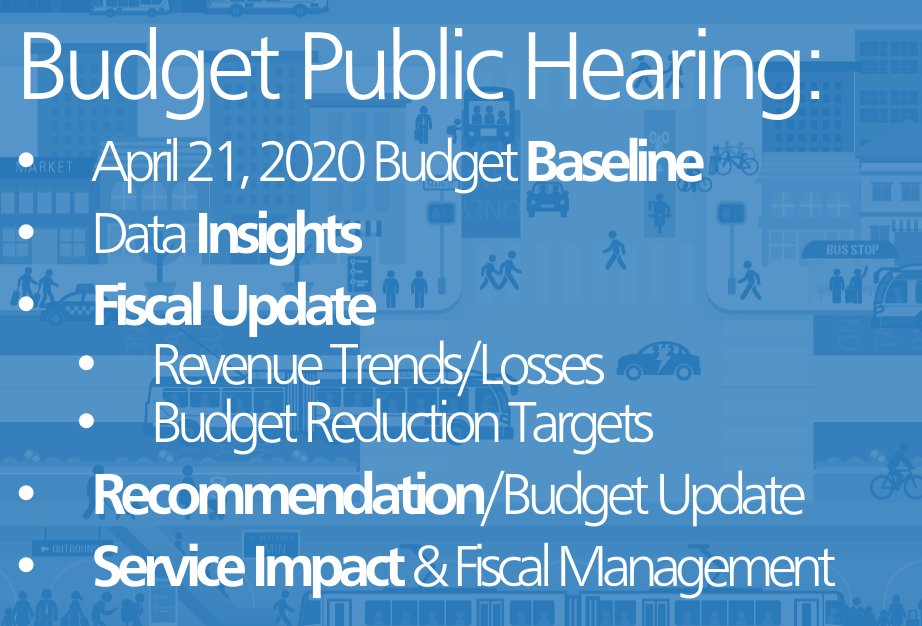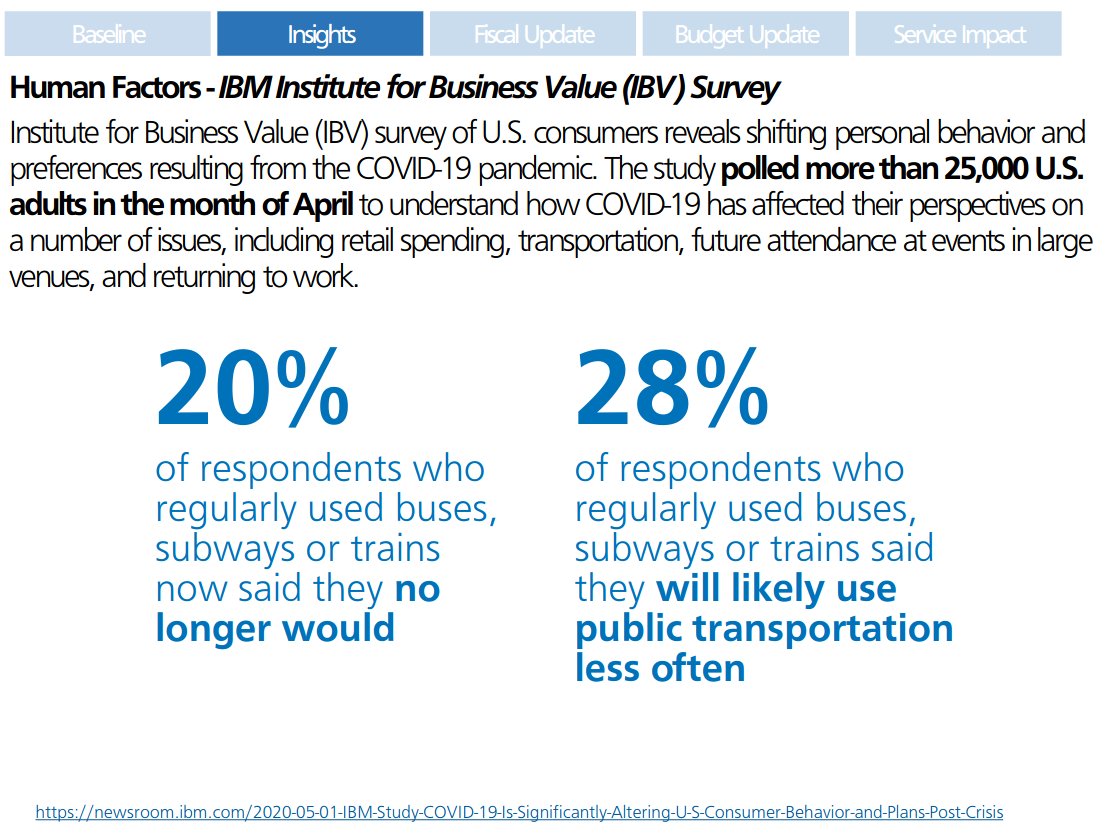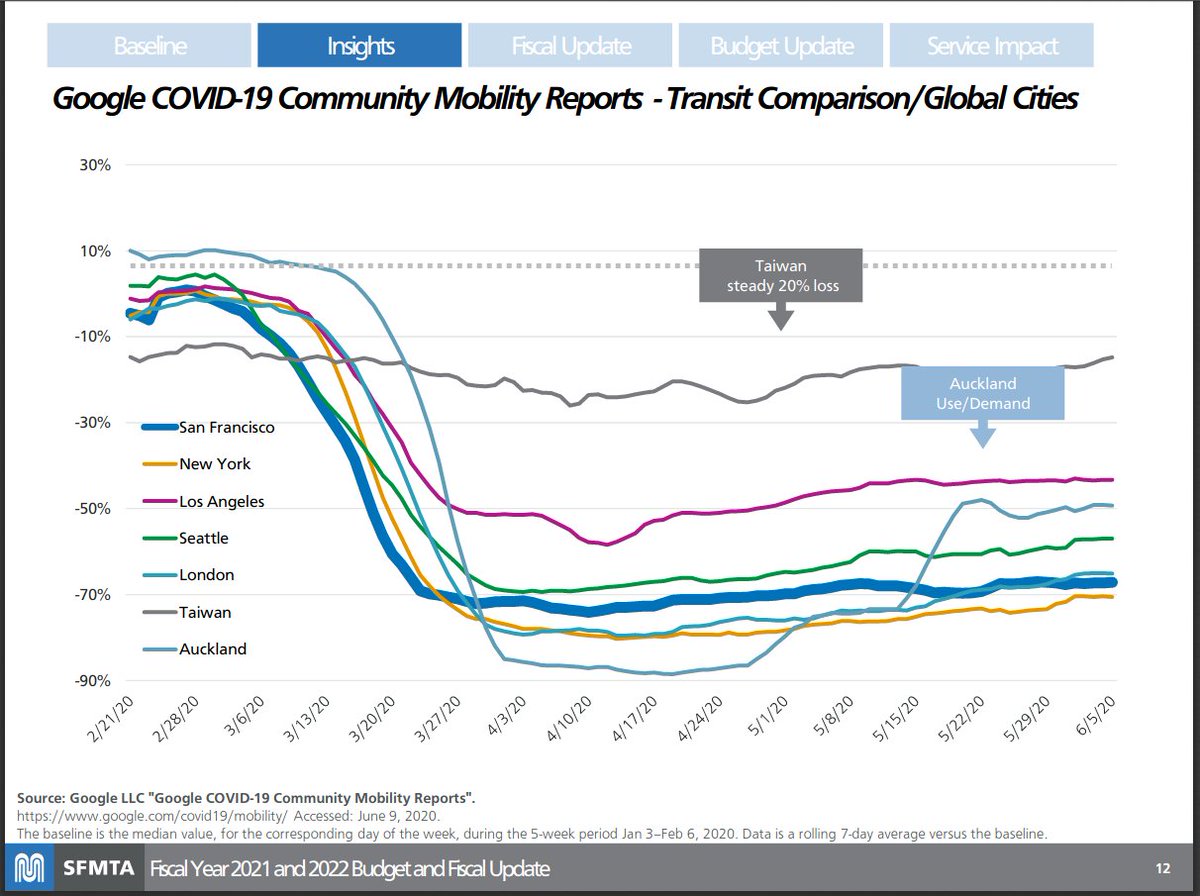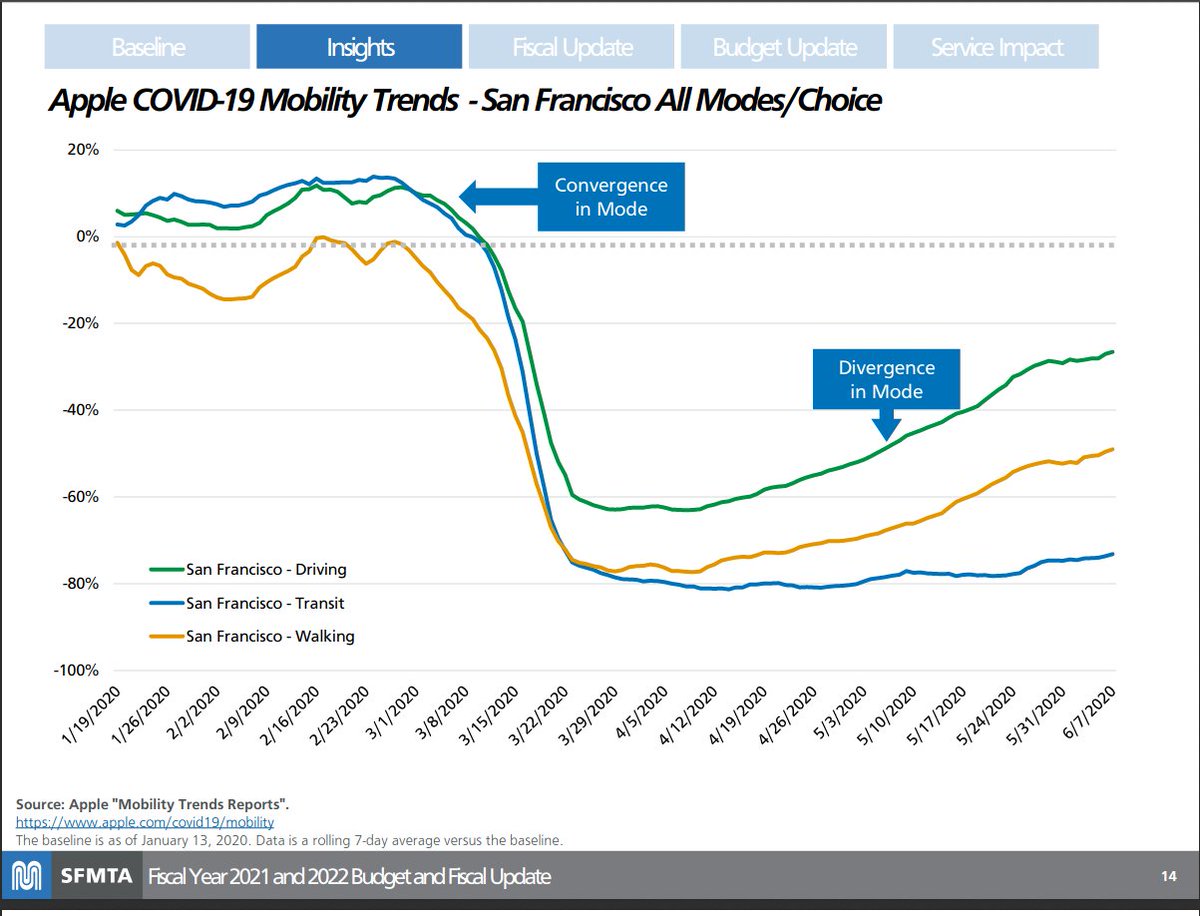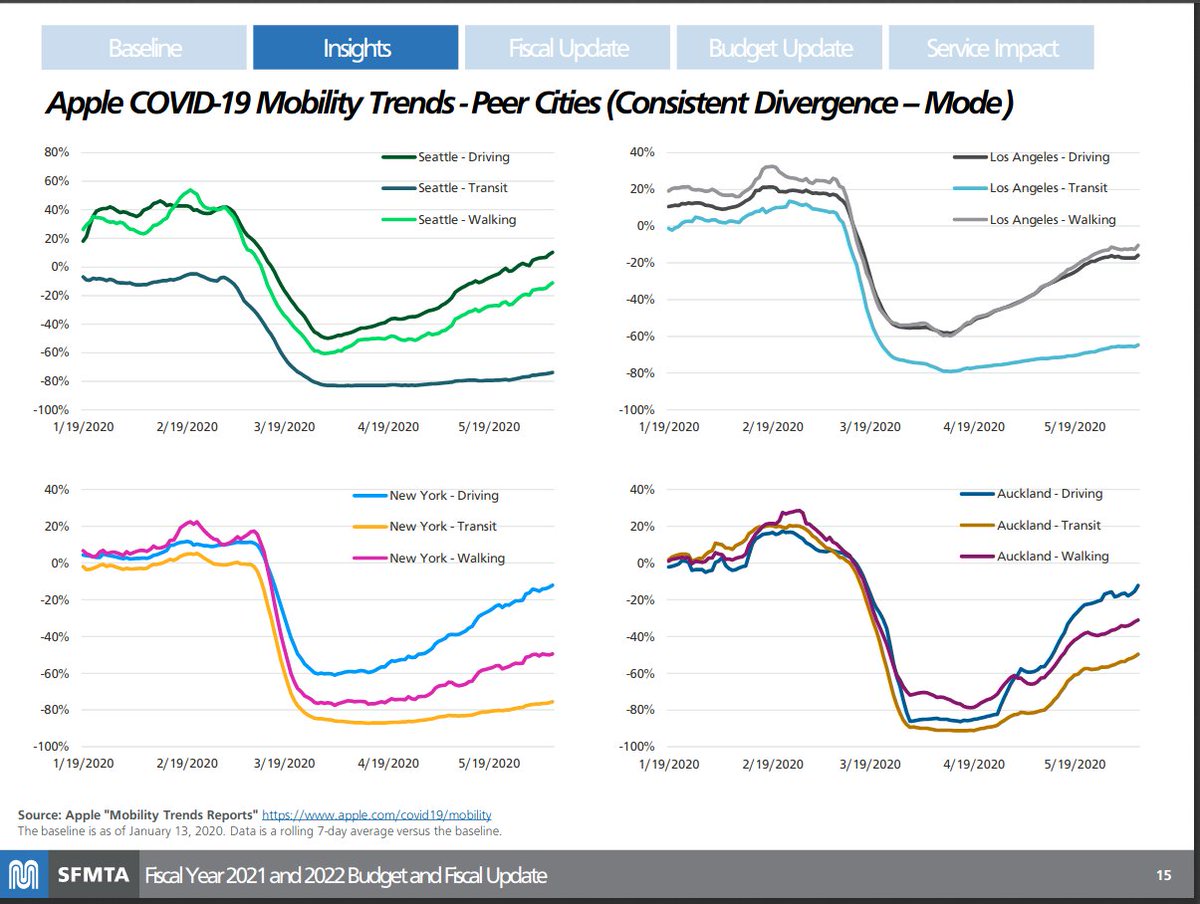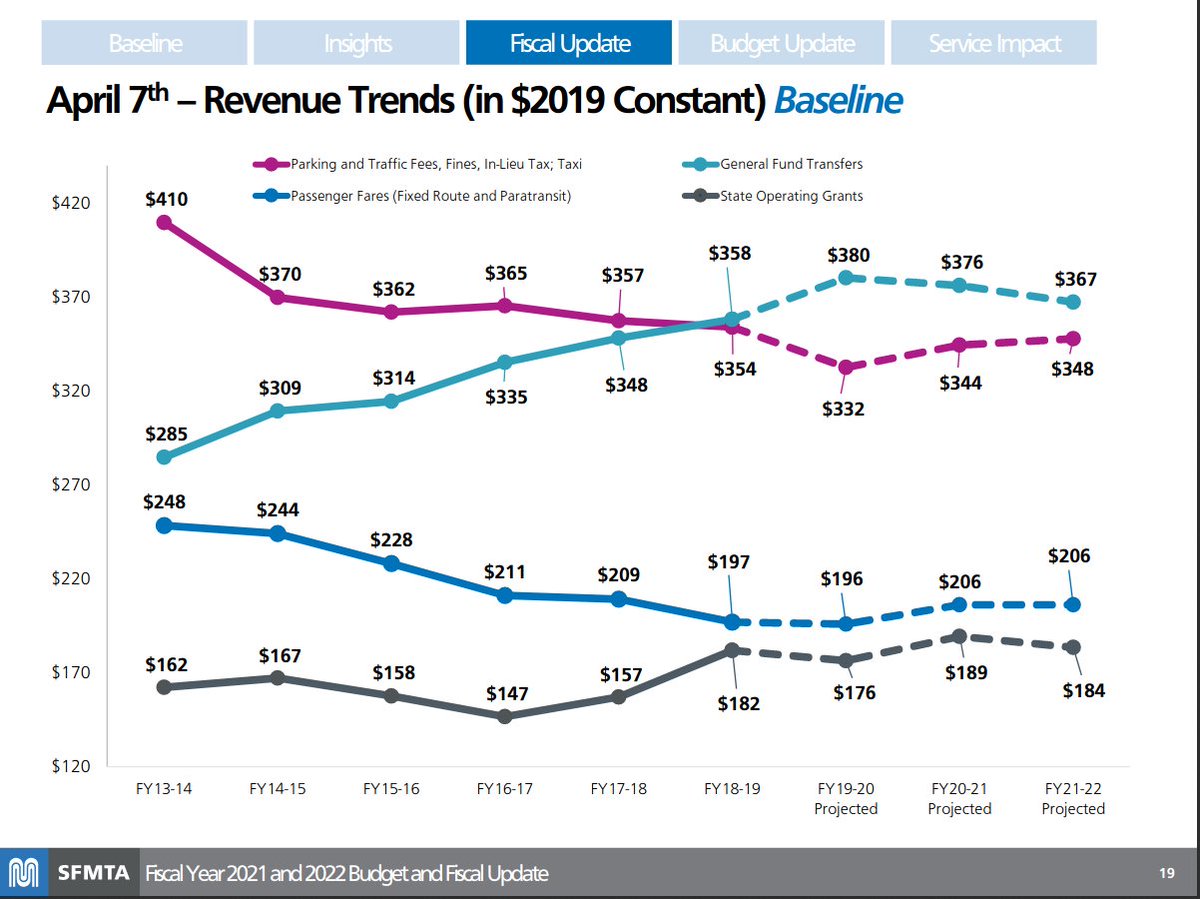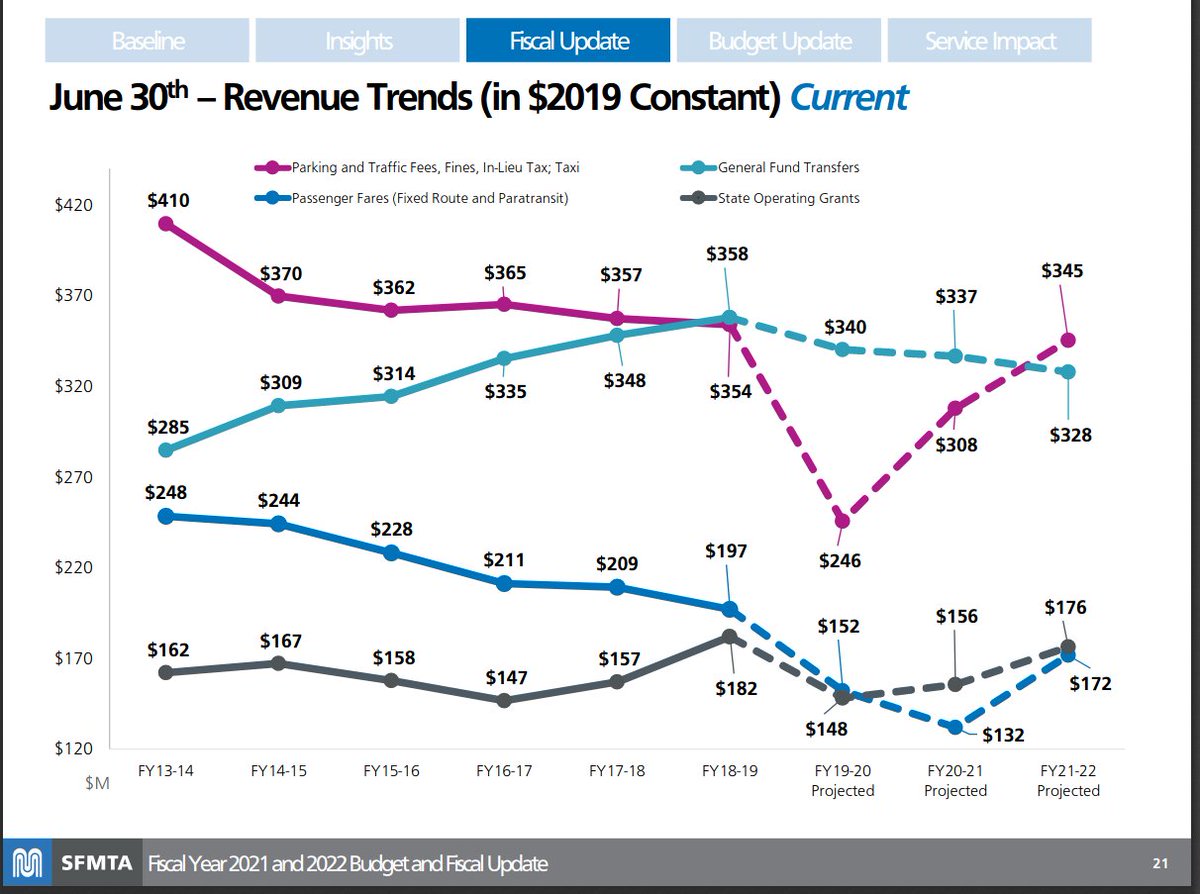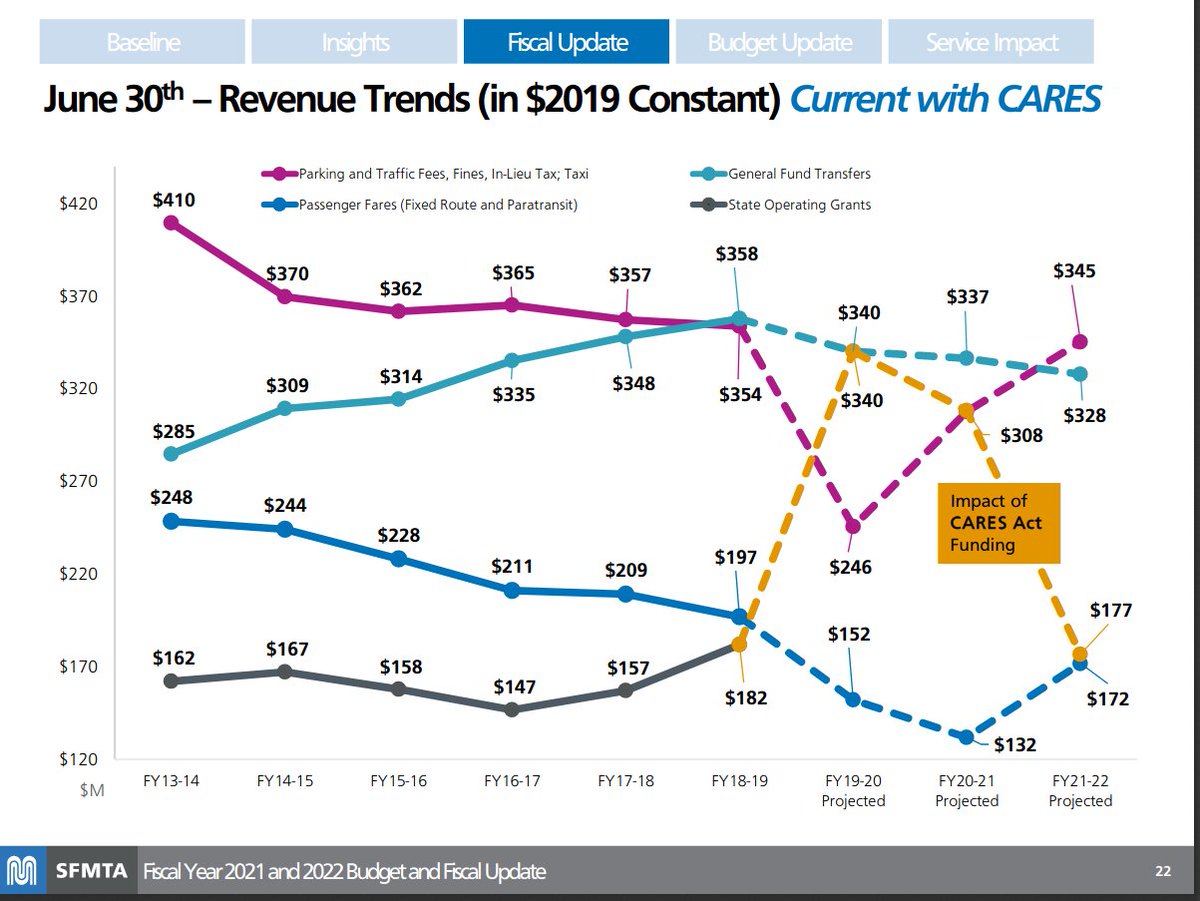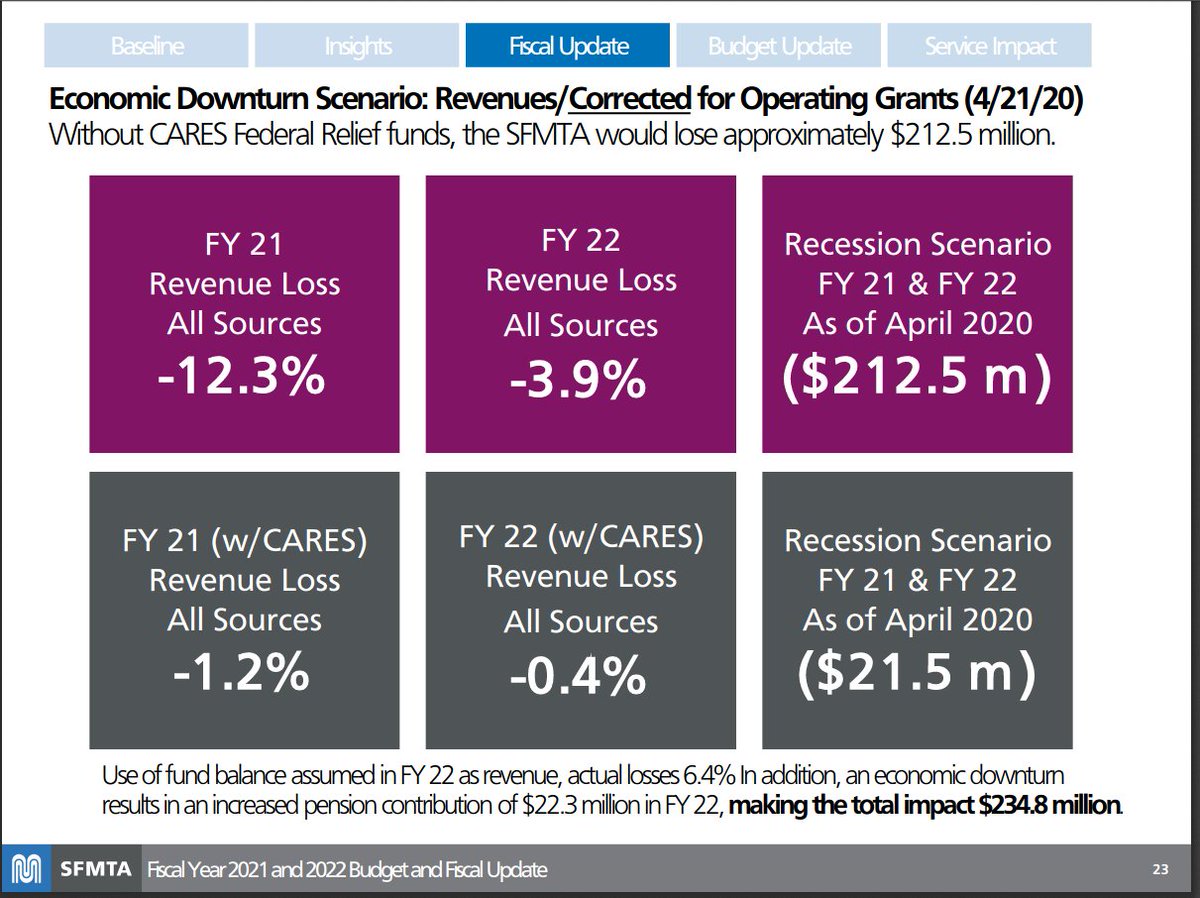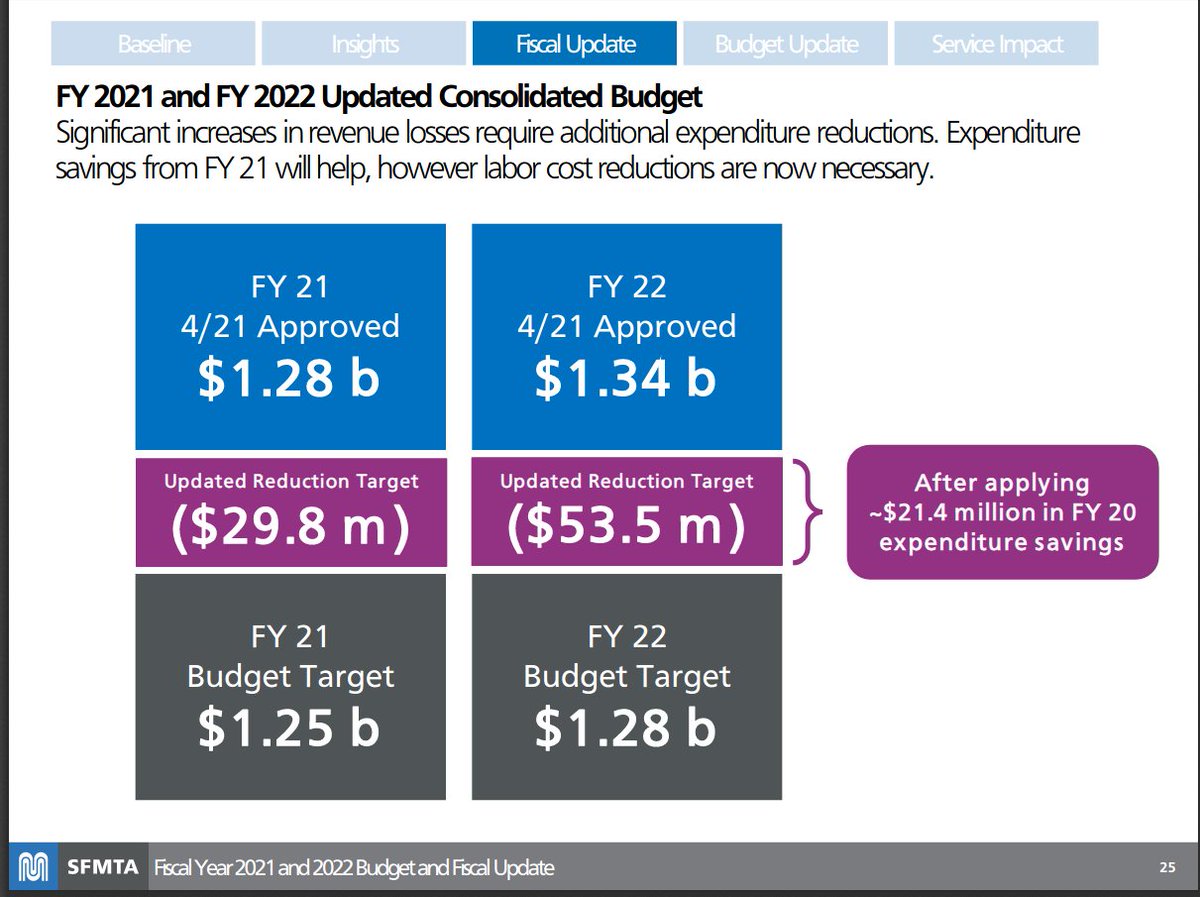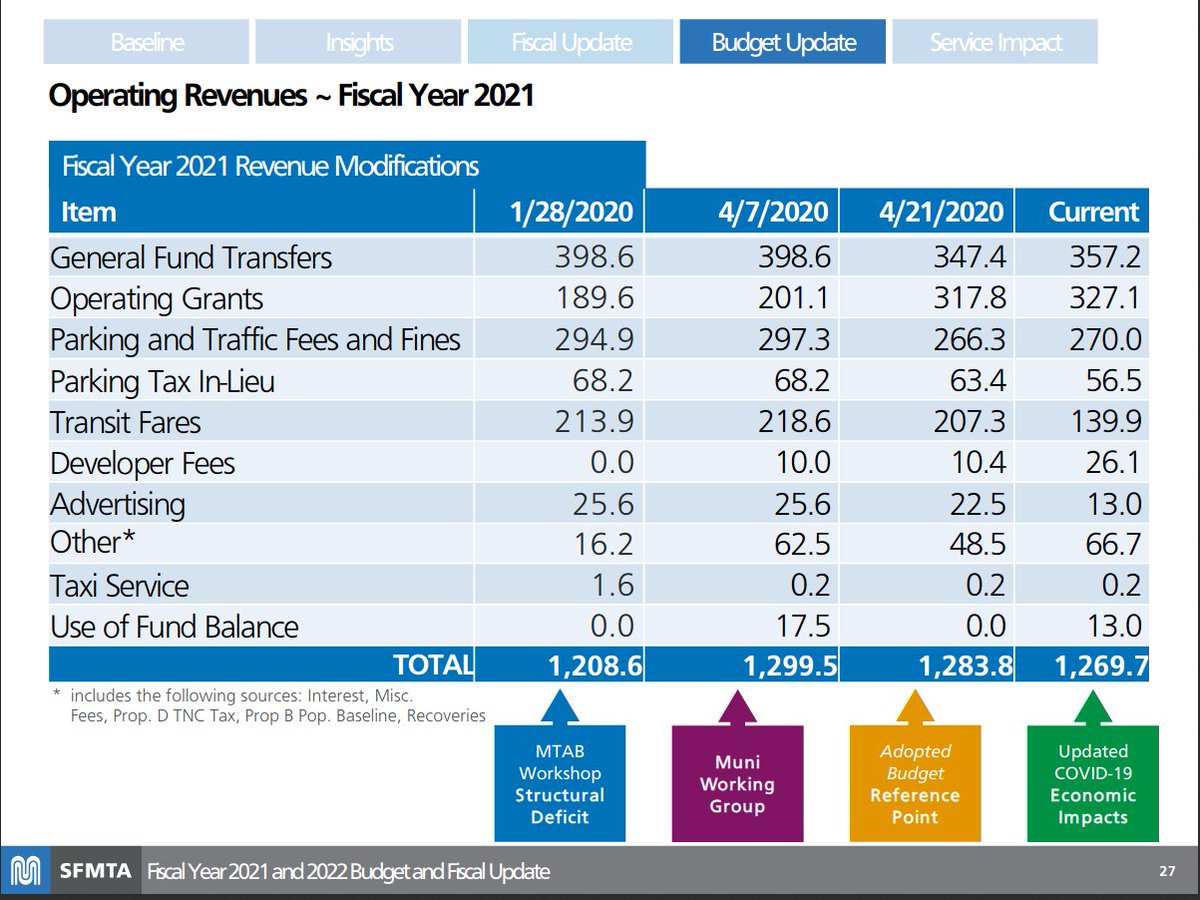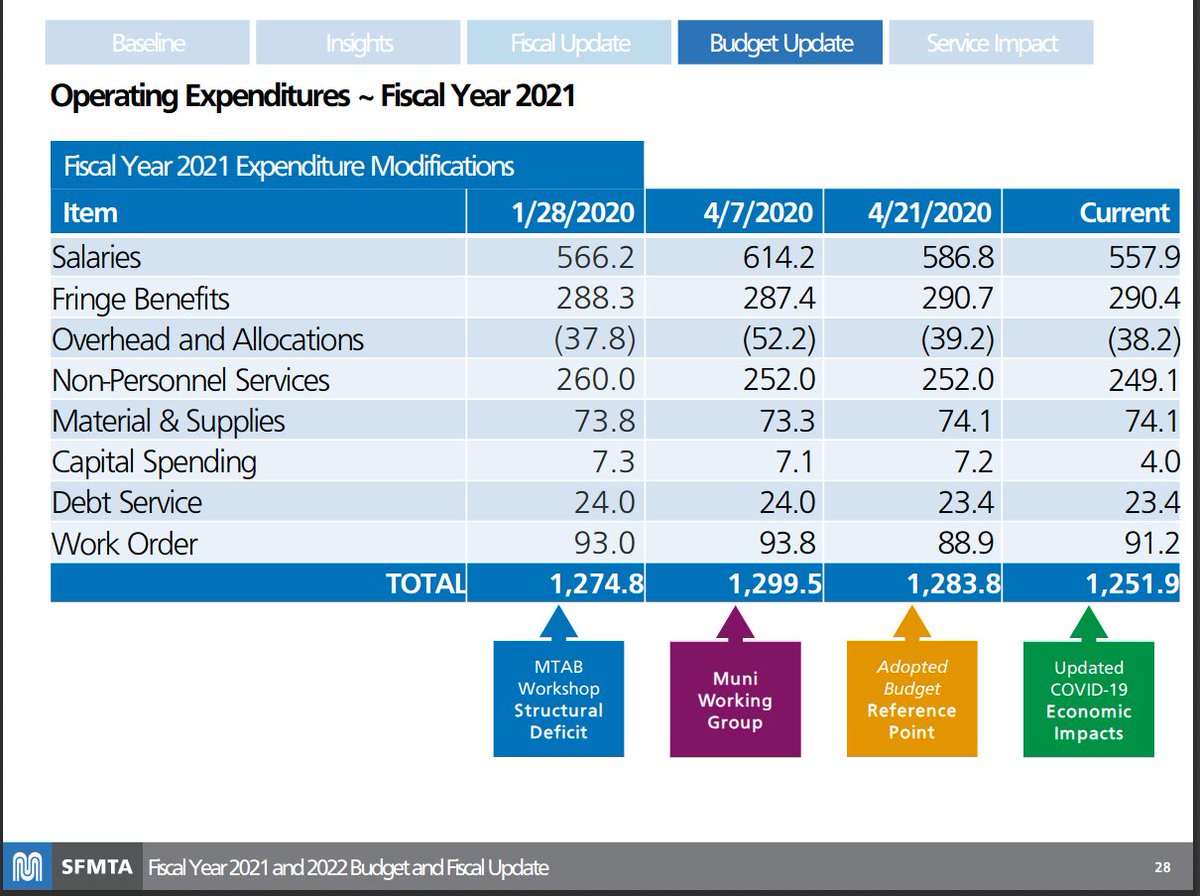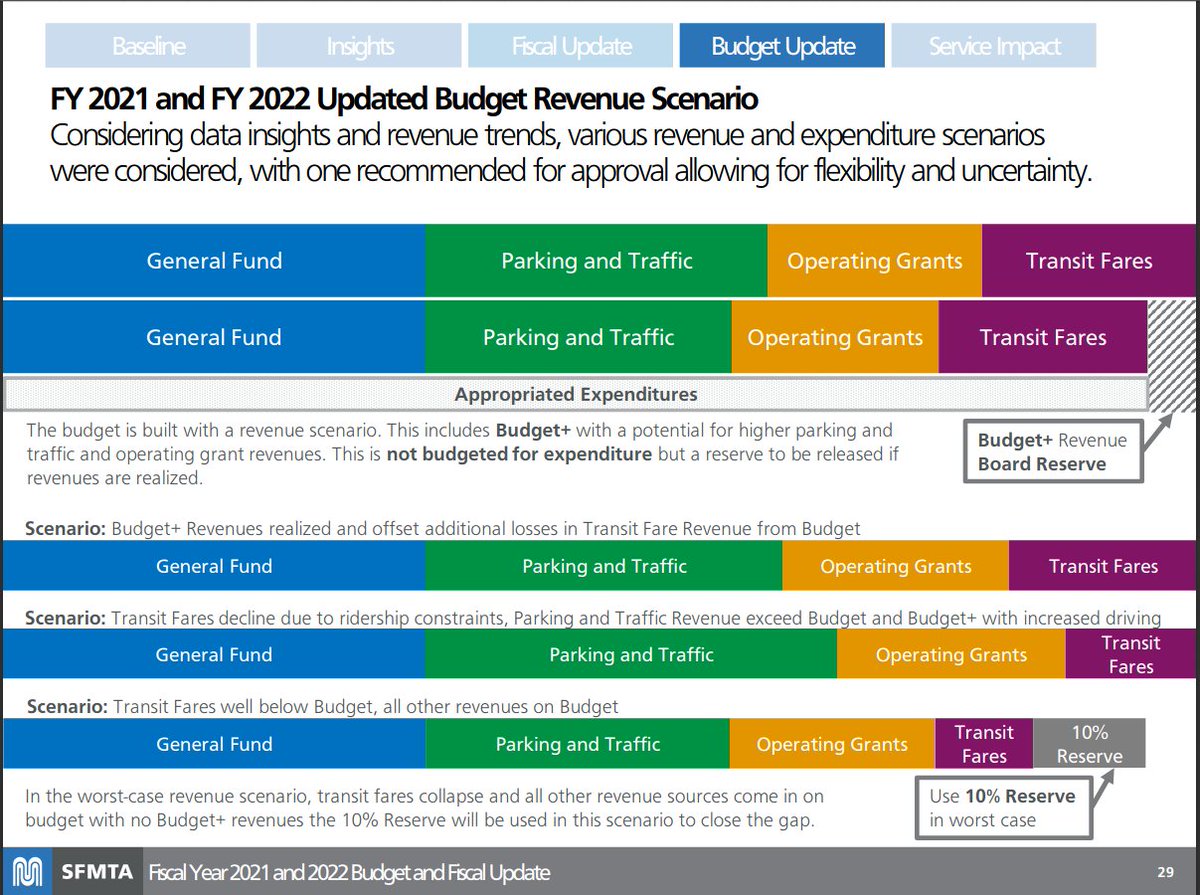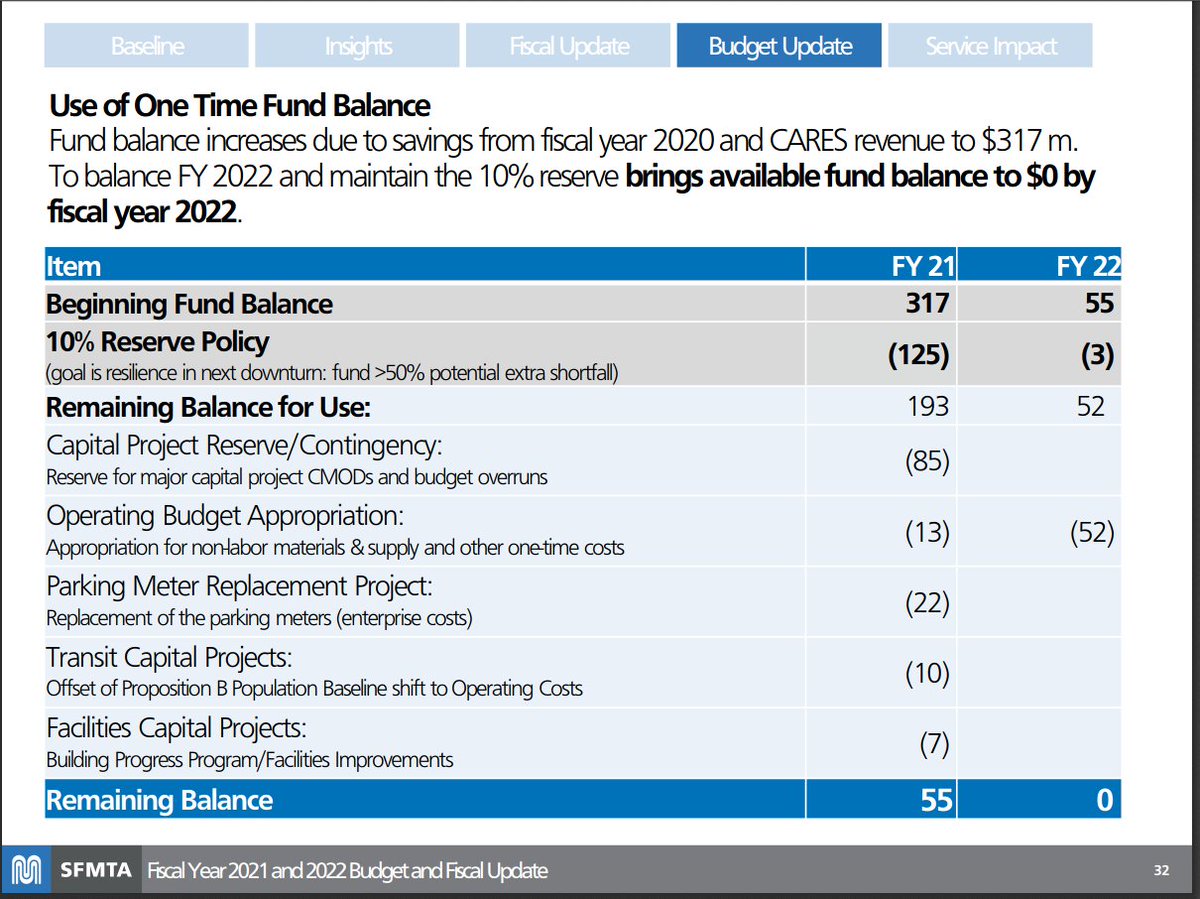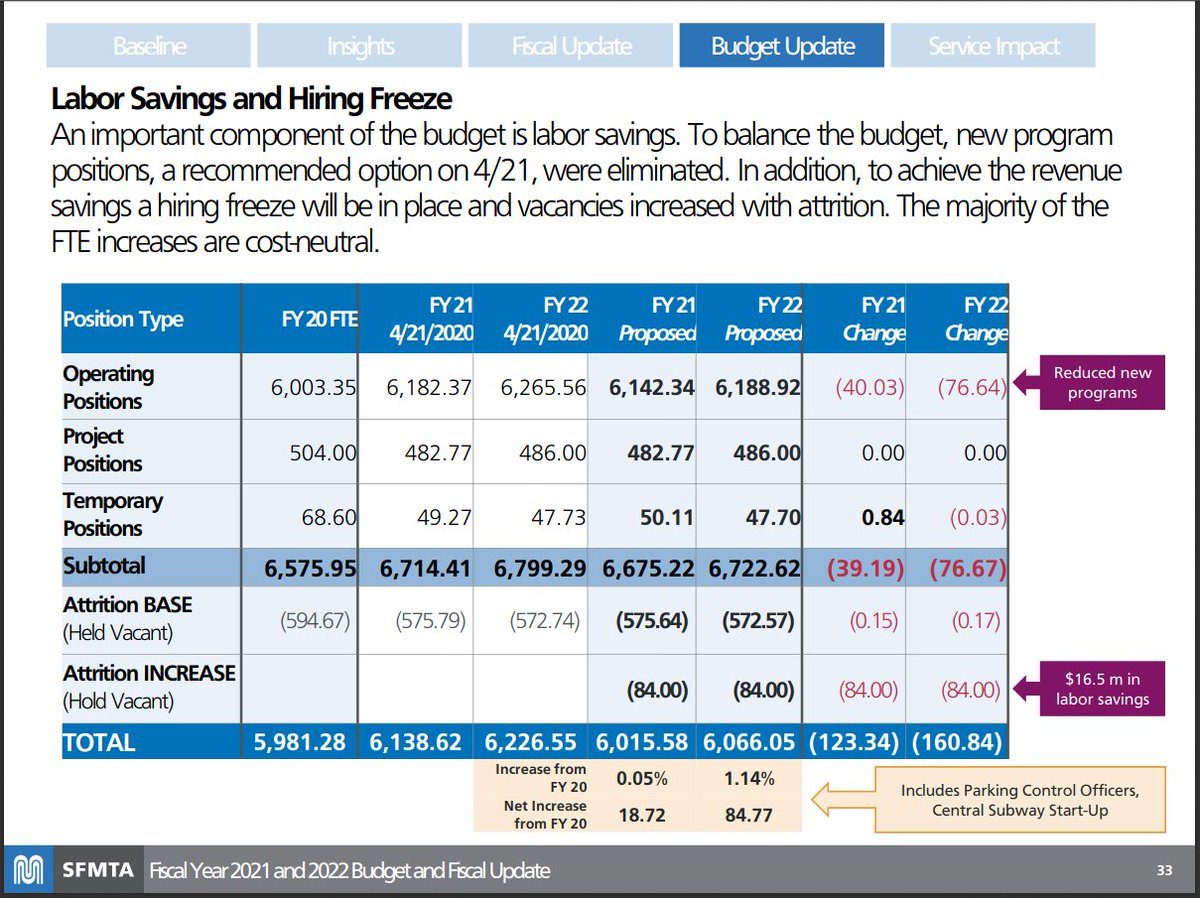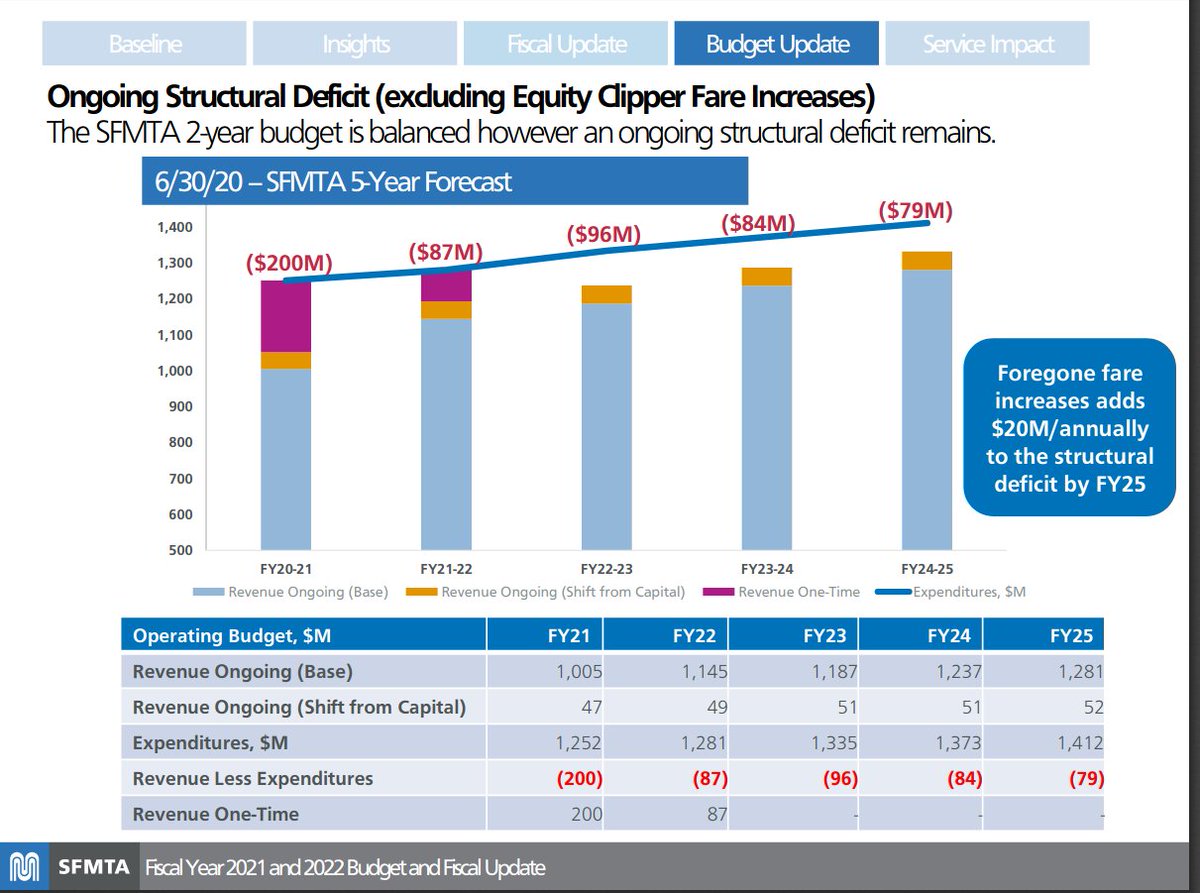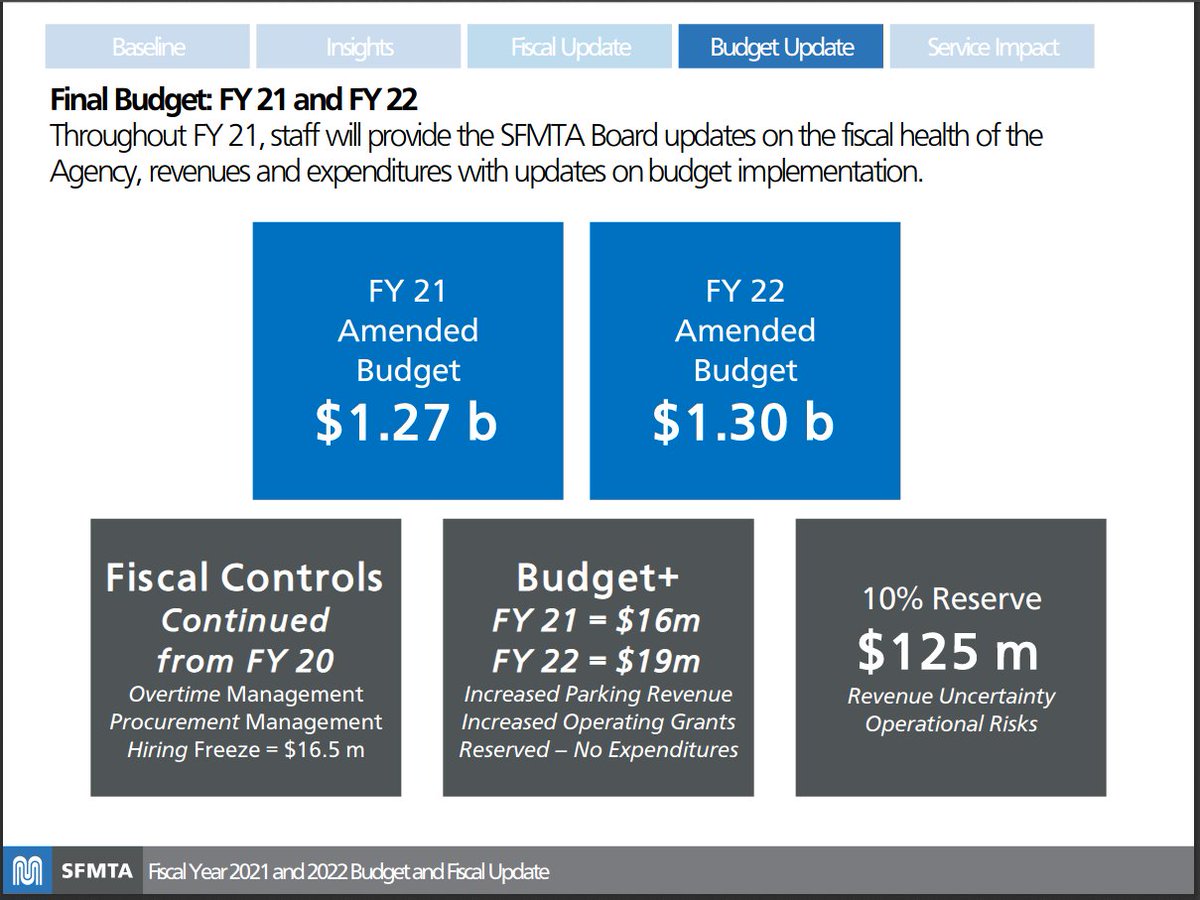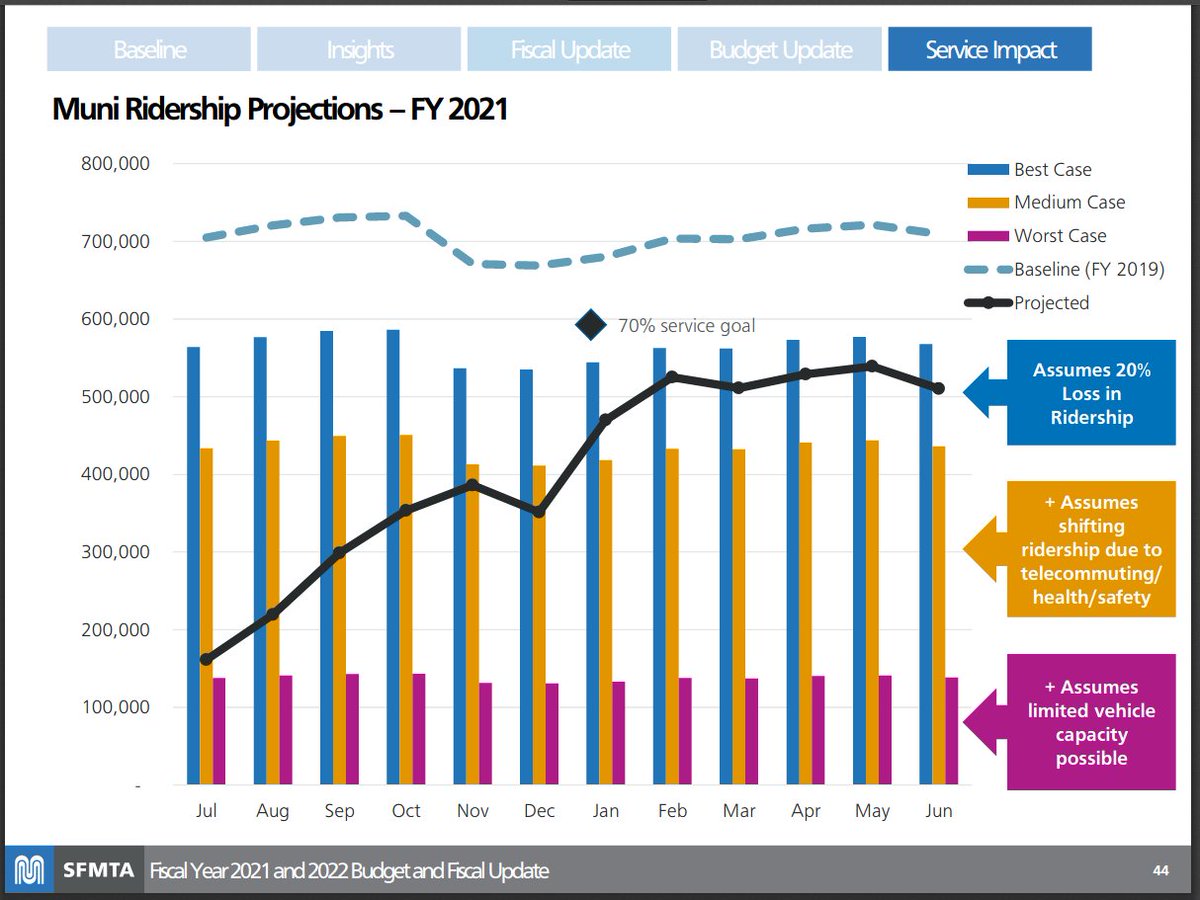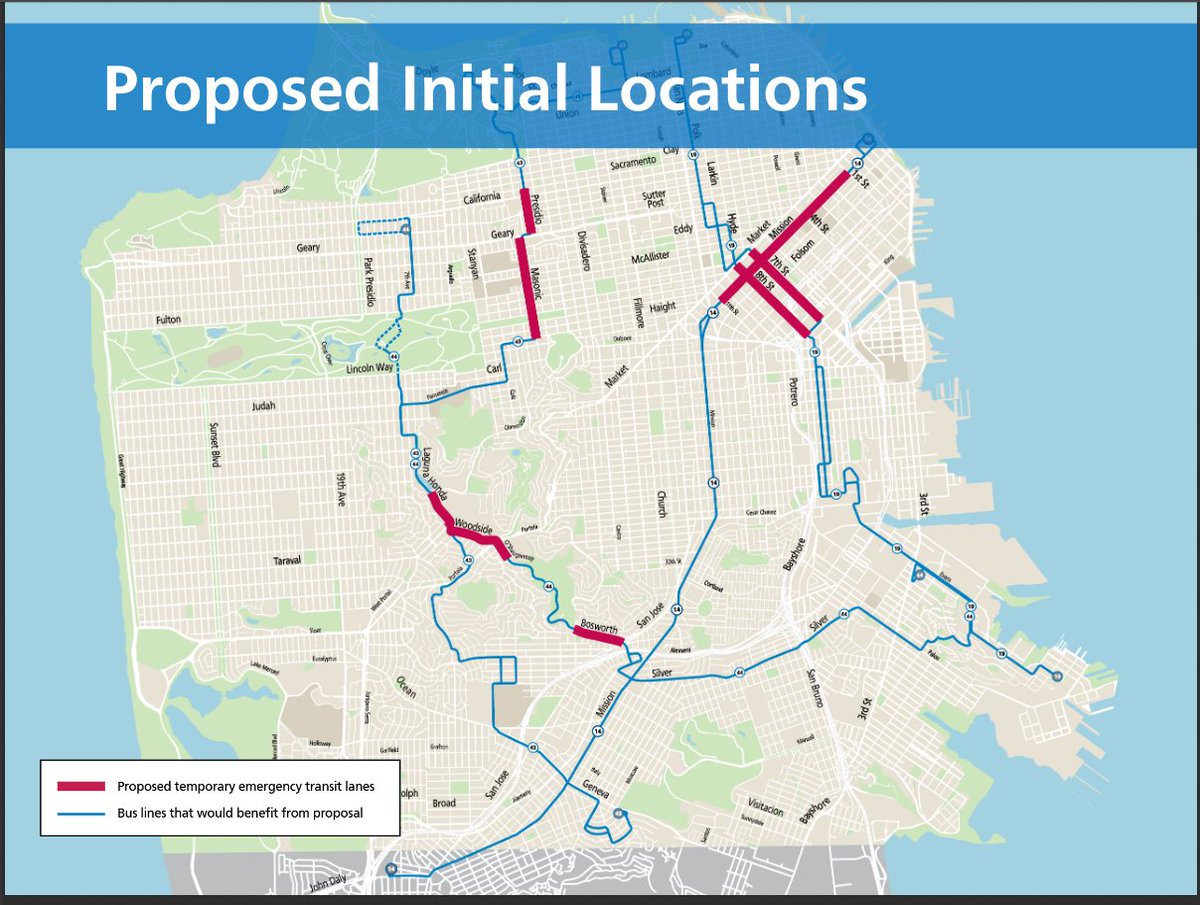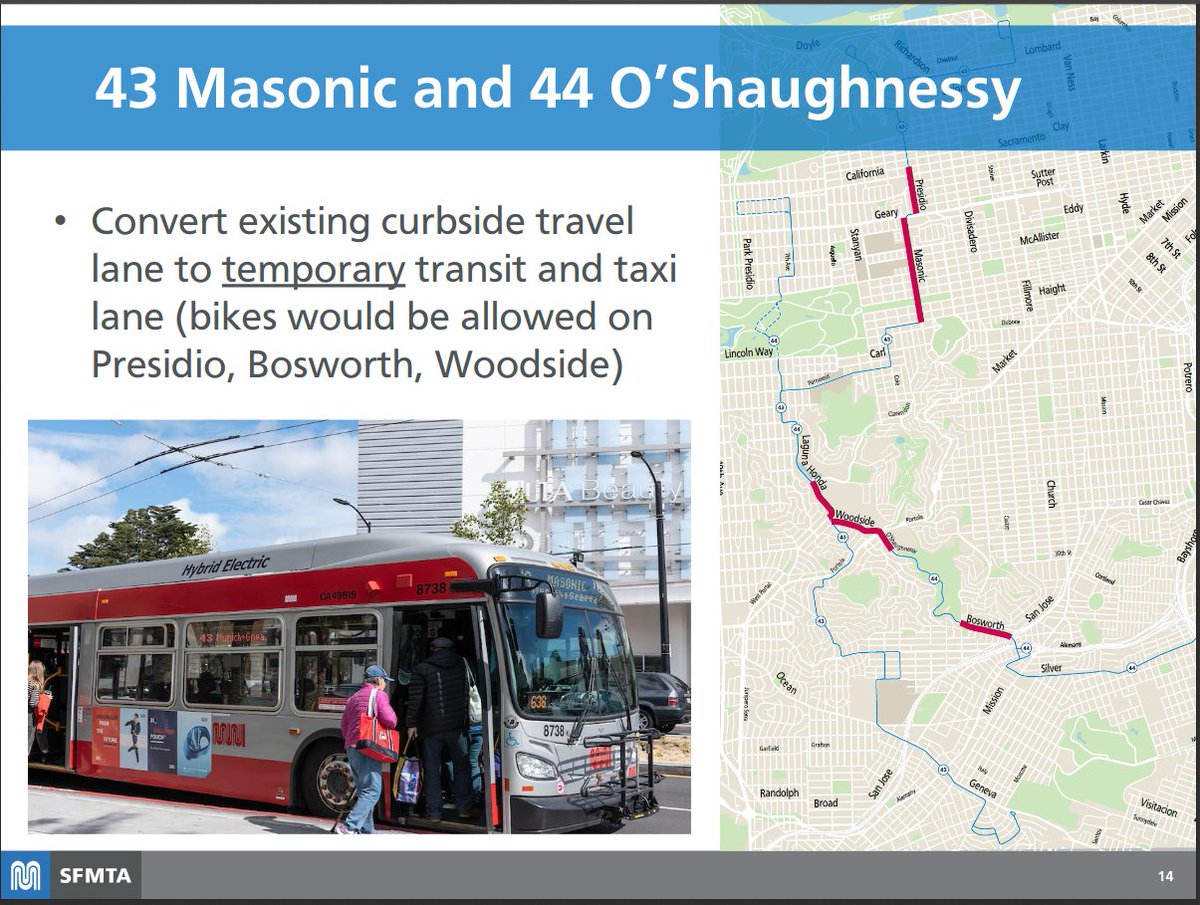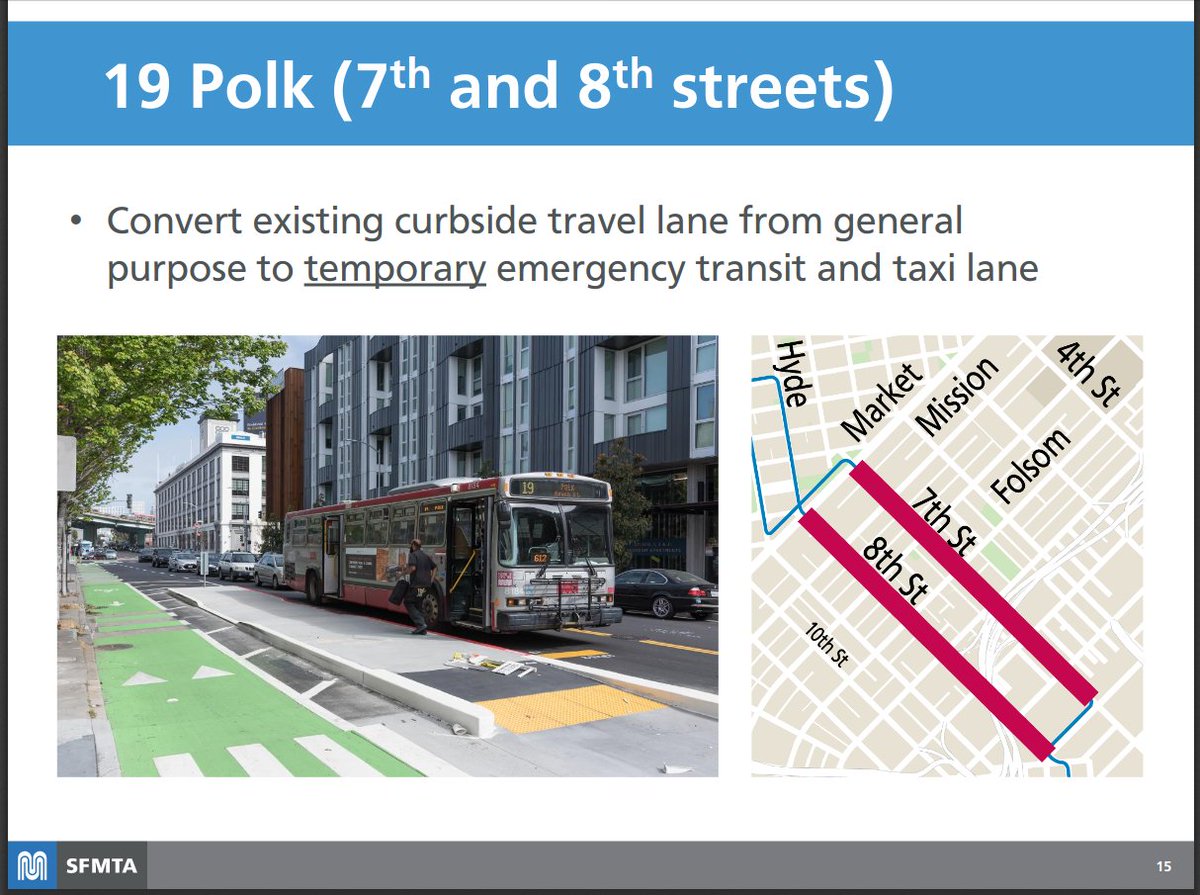HEMINGER: Is there an ADA issue with the J not going into the tunnel? Also got a report that the Sutter-Stockton garage is filthy, are we cleaning garages?
TUMLIN: Transit team is working hard on the J terminus issue. Expecting, just like at West Portal, to do quick&
TUMLIN: Transit team is working hard on the J terminus issue. Expecting, just like at West Portal, to do quick&
significant redesign to make these stops accessible. Will not start up rail service if it& #39;s not accessible. Not certain yet when we& #39;ll be able to extend to Duboce & Church, that& #39;s part of our goal. Dealing with lots of constraints.
MAGUIRE: Sutter Stockton garage is open 24/7. Did use the low demand to give all garages a thorough cleaning. Demand bounced back quickly at Sutter Stockton, will look at how we can make it cleaner. One of the few garages that& #39;s getting close to normal demand
TUMLIN: Re SB288, it& #39;s a proposed state law that would reduce CEQA analysis burden on transportation projects in the existing public right of way and do not increase vehicle miles traveled. Could remove a significant and pointless analytical burden, save us 2 years in delay
TUMLIN: From a staff perspective we can speak to benefits and potential negative side effects, and are doing that. SB288 would go a long way to have us move more quickly and efficiently on a lot of projects. City has to take a unified position, we help inform it.
EAKEN: Heartened to hear you will look at a network of Slow Streets. One gap I& #39;ve experienced is the Page Street Slow Street is very popular as a connection to GGP, but it& #39;s not easy to get to from the Mission. Gap along Sanchez and Steiner, parts of the Wiggle.
EAKEN: The Wiggle would lend itself naturally to being a Slow Street. Also a gap on Sanchez from 17th to Market.
TUMLIN: I rode all of that on my bike yesterday.
EAKEN: Shotwell working really well, but 20th Street doesn& #39;t seem to be respected by drivers as much.
TUMLIN: I rode all of that on my bike yesterday.
EAKEN: Shotwell working really well, but 20th Street doesn& #39;t seem to be respected by drivers as much.
TUMLIN: 20th and Lane are both good examples of streets where we need more robust material that are less easily driven over.
EAKEN: On Shared Spaces, do you anticipate any will not be approved? Is it just time and consideration?
EAKEN: On Shared Spaces, do you anticipate any will not be approved? Is it just time and consideration?
TUMLIN: Many applications were duplicates, those are counted as rejections. Trying to immediately approve obvious winners. Some challenges on street grade and cross slope.
MAGUIRE: Has been an opportunity for MTA in getting to yes instead analyzing everything
MAGUIRE: Has been an opportunity for MTA in getting to yes instead analyzing everything
MAGUIRE: Some businesses want to take over some or all of the street, that requires more analysis. But we only say no when there are obvious physical or operational barriers.
EAKEN: Earlier we talked about Slow Streets as a direct substitute for transit, but they& #39;re also...
EAKEN: Earlier we talked about Slow Streets as a direct substitute for transit, but they& #39;re also...
...being used for recreation. We haven& #39;t done Slow Streets in SoMa because no Muni service was cut, are we thinking about that now?
TUMLIN: Started Slow Streets in the Sunset because they had lost the most Muni services.
TUMLIN: Started Slow Streets in the Sunset because they had lost the most Muni services.
TUMLIN: Different districts have different priorities. In D10 the highest prio is maintaining and improving transit access, because of the dearth of local services. Cut the least Muni service and restored the fastest there.
TUMLIN: In D3, we heard the priority was reopening small businesses and restaurants in the parking lane. Getting lots of applications for that in North Beach. Trying to deliver what the community most wants, and being responsive to geography
TUMLIN: Finding a level residential street in D3 is hard. Re SoMa, we found that Slow Streets work best on narrower streets along a significant length. But SoMa streets are either long and wide, or short and narrow. Instead focusing on the protected bike network.
TUMLIN: Built a protected bike lane on Townsend this past week. Keeping transit service, adding temporary transit lanes. SoMa is a great location for heavily programmed play streets though. Can& #39;t just throw some barriers on the street and call it a day.
TUMLIN: Trying to meet community needs while we make it up as we go along.
Time for public comment.
SPEAKER: Looking forward to more Slow Streets, but existing ones need more barriers at key intersections
Time for public comment.
SPEAKER: Looking forward to more Slow Streets, but existing ones need more barriers at key intersections
NEXT SPEAKER: Expresses appreciation for Art Curtis
NEXT SPEAKER: @johnlisovsky thanks directors for various comments. Re Stockton Slow Street cancellation, suggesting a Slow Street on Francisco and Telegraph Hill Blvd. Argues for car-free Columbus, bike lane on North Point
NEXT SPEAKER: @johnlisovsky thanks directors for various comments. Re Stockton Slow Street cancellation, suggesting a Slow Street on Francisco and Telegraph Hill Blvd. Argues for car-free Columbus, bike lane on North Point
NEXT SPEAKER: Missed most of it, but talked about the Tenderloin
NEXT SPEAKER: Appreciate the Essential Trip Program. A lot of essential workers live/work in the TL, if you start blocking streets there taxi drivers will have very little access to pick them up / drop them off
NEXT SPEAKER: Appreciate the Essential Trip Program. A lot of essential workers live/work in the TL, if you start blocking streets there taxi drivers will have very little access to pick them up / drop them off
SPEAKER: 20th & Lane, it& #39;s hard to avoid not going through there because need access to pick up passengers or have an efficient way. Still waiting for an official list of Slow Streets from MTA. Was given a link but it& #39;s not in a form that I can distribute to taxi drivers
SPEAKER: Put up signage a block away saying that a Slow Street is ahead.
NEXT SPEAKER: About terminating the J at Church & Market and the L at West Portal. I support that but need to make the transfer safer, esp for ppl w disabilities. Iron that out before making the change
NEXT SPEAKER: About terminating the J at Church & Market and the L at West Portal. I support that but need to make the transfer safer, esp for ppl w disabilities. Iron that out before making the change
SPEAKER: Suggest a road diet on Church near Market to make the crossing safer. Thank for Slow Streets, it& #39;s incredible, do more. Page Street is a huge success. Re TL/SoMa Slow Streets, @MattHaneySF said he& #39;s open to closing streets forever, make them ped-only.
NEXT SPEAKER: @thecliffbar Mariposa Slow Street is half a block from me, happy to see it. When the barriers were moved away, SFMTA fixed it quickly. Happy to see the Shared Spaces program, wrote an op-ed in the @sfexaminer for more parklets. Focus the program on the parking lane
BARGAR: A lot of sidewalks in the city are pretty narrow, and it& #39;s disappointing to see them narrowed to the point where people can& #39;t effectively keep distance. Makes me wonder how a person on a wheelchair would navigate them. Some have also blocked bike parking.
BARGAR: Default should be to take the parking lane.
NEXT SPEAKER: Terminating J at Market is reasonable, but has to be backed up with seamless connections for ppl w disabilities. Incline up to the station; need to keep up the elevators; put up signage.
NEXT SPEAKER: Terminating J at Market is reasonable, but has to be backed up with seamless connections for ppl w disabilities. Incline up to the station; need to keep up the elevators; put up signage.
NEXT SPEAKER: @muchasita was walking w husband on a Slow Street, saw cars go through the barrier. Barriers should be enhanced. Support Shared Spaces in the parking lane. Get aggressive repurposing parking spaces for businesses and distancing.
ME: Was walking down California Street near Fillmore, ran into a restaurant with sidewalk dining. Don& #39;t think there was a 5 foot path of travel for a wheelchair, but I certainly couldn& #39;t walk there without coming close to an unmasked person. Use the parking lane instead.
NEXT SPEAKER: Support Shared Spaces, but MTA should think bigger. People complain about limited space, so take more space away from cars, especially parked cars.
NEXT SPEAKER: wants to talk about emergency transit lanes, is told this is the wrong item
NEXT SPEAKER: wants to talk about emergency transit lanes, is told this is the wrong item
NEXT SPEAKER: @MikeChenSF heartened by the progress on Slow Streets, echoes Eaken& #39;s comments on the Wiggle. In cases where flat streets are hard to find, consider slow wiggles or slow crookedness. Tumlin said SoMa had constraints w the street plan, please consider...
...changing the street plan so that we do have neighborhood scale streets in SoMa. It& #39;s not an inevitability that we have these huge arterials there.
NEXT SPEAKER: Flo Kelly from @TheCoalitionSF. Tumlin mentioned that vehicles are now getting cited for street cleaning
NEXT SPEAKER: Flo Kelly from @TheCoalitionSF. Tumlin mentioned that vehicles are now getting cited for street cleaning
KELLY: We sent a letter together with @GLIDEsf and other orgs asking not to tow or cite vehicular dwellings. People end up on the streets when their home is towed, can& #39;t afford to retrieve it.
End of public comment
End of public comment
BORDEN: We don& #39;t tow unless it& #39;s an emergency safety issue, right?
TUMLIN: Yes. Worked with advocates to develop a plan for this back at the start of the pandemic.
BORDEN: Are we towing cars with lots of tickets?
TUMLIN: No, only for safety issues.
TUMLIN: Yes. Worked with advocates to develop a plan for this back at the start of the pandemic.
BORDEN: Are we towing cars with lots of tickets?
TUMLIN: No, only for safety issues.
BRINKMAN: People don& #39;t realize how much SFMTA talks to other cities. Had not thought about the emergency access question, but other cities have closed entire streets for restaurants. How are they handling that?
TUMLIN: Important topic with peers all over the world. Different countries take radically different approaches to emergency access and risk management. In Japan, bc the geography is so different, they minimize the size of their fire trucks.
TUMLIN: Other cities take a different approach to risk, tolerate longer response times. Fire is part of SF& #39;s ancestral memory, it& #39;s why the phoenix is on our flag, and why we have more fire houses per capita than most other places in the country.
TUMLIN: SFFD must approve all street changes. Our buildings are made out of wood, we& #39;re prone to natural disasters. Sometimes this slows our work down or makes it very difficult. Old buildings with fire escapes through the window impact what we can do on the street.
Next item: the revised budget. Leo Levenson (CFO) presenting. Presentation: https://www.sfmta.com/sites/default/files/reports-and-documents/2020/06/6-30-20_item_9_fy21_and_fy_22_budget_-_slide_presentation.pdf
LEVENSON:">https://www.sfmta.com/sites/def... Budget was approved in April, but due to covid we need an update already.
LEVENSON:">https://www.sfmta.com/sites/def... Budget was approved in April, but due to covid we need an update already.
LEVENSON: $30M in cuts in 2020-21 (FY21), $45M in FY22. Most cuts are holding positions vacant, since labor is 60% of the budget. Due to worse revenue outlook due to covid, and also from foregoing fare increases. Lots of uncertainty, will have to see what happens to ridership
LEVENSON: Also depends on what the public health requirements will be for riding transit. Budget contains a 10% contingency reserve, in case things get worse. Will be monitoring closely, reporting at least quarterly, will present options if revenue is too low.
LEVENSON: Budget only balanced due to one-time sources. A lot of that is CARES Act money from the federal government. We also built up a surplus in our reserve, which we& #39;re now spending down.
Jonathan Rewers, senior budget manager takes over
Jonathan Rewers, senior budget manager takes over
REWERS: (Slide 4) Budget is based on values. Added a value for supporting economic recovery. (Slide 5) Said back in April that the budget was a baseline that we& #39;d modify later. Our control in April was canceling certain programs if there were revenue losses.
REWERS: (slide 7) Anticipate ridership will be lower for some time. Auckland is covid-free but still has lower ridership. Regular riders will be shifting to occasional, as fewer people travel to work. Service increases do drive ridership increases, in the short term.
REWERS: People shifting from transit to driving, too. (slide 8) Used an IBM survey with 25k people, and Google and Apple& #39;s mobility reports. Maps apps have data about where people are going and which modes they& #39;re choosing.
REWERS: (slide 9) People say they& #39;ll use transit less (slide 10) and drive more, but take Uber/Lyft and taxis less. Difference between Uber/Lyft and taxis is interesting.
REWERS: (slide 11) The "workplace" and "transit" lines in this graph are diverging, meaning more people are going to work without transit.
REWERS: (slide 12) Looking in particular at Taiwan and Auckland. Transit use back up, but not back to normal.
REWERS: (slide 13) Driving is coming back faster, and very close to normal in Seattle. (slide 14) Driving and transit fell together in SF, but driving is recovering much faster. (slide 15) The same thing happened in other cities
REWERS: So how does that affect us? (slide 17) Projecting 19% revenue losses. Using a lot of one-time sources in FY21, at first we thought our revenues would recover in time to not have to do that in FY22. But not we don& #39;t think that, so we& #39;re solving for a deficit in FY22.
REWERS: Lots of unknowns, so tried to be conservative and add resiliencies. The budget isn& #39;t sustainable, but it is resilient. The structural deficit is increasing. Sustainable revenues were already declining, now even faster. Canceling fare increases makes this worse.
REWERS: (slide 18) $568M revenue loss over 4 years, $46M in increased pension contributions. Slide 19 was the revenue trends pre-covid. Slide 20: what we said in April. Slide 21: what we think now. Fare revenues declining, state funding probably will too.
REWERS: (slide 22) Impact of the CARES Act money, fills a big gap. Will use the full amount in FY21, not what we had planned in April. CARES Act and other one-time sources will not hold up long enough, so had to make cuts.
REWERS: (slide 23) Correction for April slides: in April we accounted for $212M revenue losses, $21M after CARES Act filling the gap. (slide 24) Now we think that& #39;s $332M and $105M. Needed an additional $84M in cuts
REWERS: (slide 25) In FY20 the CARES money didn& #39;t quite compensate for our revenue losses, but we managed to save enough by canceling purchases etc
REWERS: (slide 27) In January we already had a structural deficit. April 7th: tried to get revenues to fund additional programs. April 21st: reduced revenue to account for covid. Current: even less revenue
REWERS: (slide 28) Changes to expenditures in each version of the budget. (slide 29) Here& #39;s how we created stability. Note revenues were higher than expenditures in the previous slides. The hashed line on the right is the difference.
REWERS: Parking revenue might be higher, fare revenue might be lower. In that scenario, maybe the budget is still balanced if the parking revenue is high enough, or maybe it won& #39;t be. Worst case, all revenues come in at the lowest level, and we& #39;ll have to use our 10% reserve.
REWERS: Budgeted expenditures conservatively so that we only need the reserve if all revenues come in low. (slide 30) Revenues overview. Want to point out use of fund balance and use of transit development fees. Huge use of one-time funding sources
REWERS: (slide 31) Expenditures overview. (slide 32) Use of one-time fund balance. Largely the same as before. Due to savings from FY20 we have a little bit more money in the fund, and the 10% reserve requirement is lower because the budget is lower.
REWERS: Capital expenditures are the minimum we need to do to keep things running. After these two years, the remaining balance is 0. We won& #39;t have any one-time fund balance left. (slide 33) Did everything possible to avoid layoffs. Needed $16.5M in labor savings.
REWERS: Will hold more positions vacant. As people leave, we won& #39;t replace them, unless absolutely necessary. Only increases in FTE are needing more parking control officers and staffing for Central Subway when it opens. Need station agents, rail maintenance, etc.
REWERS: (slide 34, 35) Everything we told you not to do in January, we are now doing in order to balance the budget. Will result in a beginning deficit in FY23 of $73-100M. We will not be able to overcome that without cutting service.
REWERS: (slide 36, 37) Structural deficit over the years. Purple is one-time revenue, we& #39;ll run out of that in 2 years. Orange is shifting money from state of good repair to operating. And that& #39;s with fare increases, without (slide 38) it& #39;s worse
REWERS: We will need to solve this structural problem with new funding. And remember, this isn& #39;t even the full cost of running SFMTA, it& #39;s with reduced service already. (slide 39) There will be $110M of repairs that should have been done but won& #39;t be. Need $472M just to keep up
REWERS: (slide 40) Overall budget $1.27B, with a hiring freeze, will be hiring very sparingly. Have a buffer for loss of revenue, and a 10% reserve for loss of even more revenue
REWERS: (slide 42) The transit system will be different for a long time. Distancing reduces the number of people we can carry. Will continue to expand walking and cycling, and funding Shared Spaces
REWERS: (slide 43) To date we& #39;ve increased cleaning, launched an ambassador program, Slow Streets, and waived taxi fees.
(slide 44) Ridership projections. Dotted line: 2019 ridership. Blue bar: assume 20% reduction in ridership to start with.
(slide 44) Ridership projections. Dotted line: 2019 ridership. Blue bar: assume 20% reduction in ridership to start with.
REWERS: Orange bar adds in mode shift, more realistic. Purple bar is what our capacity would be if we ran 70% of service and had to maintain distancing. We just cannot carry enough people. it& #39;s physically impossible.
REWERS: Black line is what we think could happen. Reopening rail in August, school year starting. Demand follows increase in service hours. Hit 70% service goal in January. This is definitely an optimistic scenario.
REWERS: (slide 45) Overview of what& #39;s in the budget. Office of Race, Equity and Inclusion will still be created, but more limited. Still planning for 70% of service, hiring ambassadors, starting the Central Subway, Slow Streets and Shared Spaces.
REWERS: (slide 46) Outstanding risks and unknowns. Fare collection, vehicle capacity, what if the virus resurges and there& #39;s a complete shutdown again? What if revenues don& #39;t go back up? What if we hit supply chain issues?
REWERS: My team built 3 full budgets in 6-7 weeks each that would normally take 6-7 months. They do all the work, I& #39;m just a talking head.
Time for public comment.
SPEAKER: In support of transit-only lanes; is told this is the wrong item.
NEXT SPEAKER: Don& #39;t believe revised budget was presented to the CAC, nor was their an online webinar, those would be helpful. Have more online budget/policy forums going forward
SPEAKER: In support of transit-only lanes; is told this is the wrong item.
NEXT SPEAKER: Don& #39;t believe revised budget was presented to the CAC, nor was their an online webinar, those would be helpful. Have more online budget/policy forums going forward
SPEAKER: I support a lot of the things in here, but am concerned about the appropriated board reserve. I would not appropriate those funds, leave them in reserve, and have staff ask for them if they& #39;re need them. Concerned that spending down reserves...
...trades off the current system for the future. Skimps on state of good repair.
NEXT SPEAKER @johnlisovsky: Appreciate no layoffs, not a fan of attrition because it reduces union membership. A crisis like this is when we should increase revenues from driving.
NEXT SPEAKER @johnlisovsky: Appreciate no layoffs, not a fan of attrition because it reduces union membership. A crisis like this is when we should increase revenues from driving.
LISOVSKY: Charge more for parking. Transition infrastructure from cars to sustainable transportation. Congestion charge is needed, London gets billions of pounds a year from it. Politically costly, but necessary to have an intact MTA.
NEXT SPEAKER (Roger Marenco): Challenge city leaders to take a 10% pay cut, as I have. How much would the city save, if everyone who makes what I make or more took a 10% pay cut?
NEXT SPEAKER (Aleta Dupree): Thank you for not raising fares. Clipper START will be turned on on July 15th, can attract more customers paying reduced fares with Clipper cards. Reduced-fare customers are essential to the system. Reduced fares must never mean reduced service.
ME: There& #39;s a structural deficit, needs to be closed with new venue. Bring back the Vehicle License Fee proposal from 2014, and/or otherwise charge drivers more. It is not equitable to increase fares on transit riders (which you& #39;re thankfully not doing) but not fees on drivers
NEXT SPEAKER: Good that Free Muni wasn& #39;t cut. Why spend money on new 40-foot buses, didn& #39;t we just buy hundreds of those? Also support raising parking and driving fees, cut salaries for high earners.
NEXT SPEAKER (Zack Deutsch-Gross from @SFTRU): Sorry to see the loss of the Free Muni for All Youth program. Need to remove as many barriers as possible to encourage ridership, esp among youth. Look forward to finding more equitable funding sources for Muni.
NEXT SPEAKER (Bob Allen from Urban Habitat): Echo comments about new sources of funding, concerning that MTA has to burn through one-time reserves. Need to shift state funding from highways to transit, and think about a potential ballot measure down the line, even if it& #39;s in 2024
ALLEN: Cutting $2M for Free Muni for Youth affects transit-dependent communities, fund it by dialing up costs for those who can afford more.
NEXT SPEAKER: Thanks for waiving taxi fees. Also important to have parking control officers during the evenings and weekends, more revenue
NEXT SPEAKER: Thanks for waiving taxi fees. Also important to have parking control officers during the evenings and weekends, more revenue
NEXT SPEAKER (program coordinator for Back First): Many front line workers have been calling to reinstate Back First. There have been petitions. This is not the time to cancel Back First.
NEXT SPEAKER: Echo what other people said about finding new ways to raise revenue from car owners. I used to own a car, was stunned how cheap my parking permit was. Nothing should be off the table to encourage mode shift from cars to transit, esp given the climate emergency.
NEXT SPEAKER ( @themartinmunoz): SFMTA is going to lose millions of dollars in revenue in the next few years. The time has come for congestion pricing, provides funding for transit and creates safer street.
NEXT SPEAKER: Reason why there& #39;s less use of transit is the service is miserable. Reducing it will make it worse. Crowding on buses is due to the lack of other lines. Return service to all lines that normally run on Saturdays.
SPEAKER: Expenses like bulb outs and street modifications should be eliminated, use the money to fund transit. Bicyclists should be paying for licenses and for parking. They drive moving vehicles like car owners do, they have a responsibility to the city, esp in this pandemic.
NEXT SPEAKER (PCO union president): Need to support parking control officers who have to enforce all these parking changes and street closures. Continue to call for safer working conditions for PCOs.
NEXT SPEAKER: Urge SFMTA to address systematic racism that has been an issue historically. Car cleaners and front line service staff are largely POC, have more underlying health conditions, more susceptible to the virus. Back First help with this.
SPEAKER: To take a knee for George Floyd is a gesture. To actually help POC, adequately fund Back First, without layoffs and service cuts. Cutting management salaries would be a good start.
NEXT SPEAKER ( @_fruchtose): Support Slow Streets, taking cars off the road, Sunday parking meters. The parking situation in the city benefits drivers. Like market pricing for parking because it& #39;s limited.
NEXT SPEAKER (director of Back First): Celebration for the top 20 operators this morning. Lots of people have expressed support for Back First. According to MTA& #39;s own data, return on investment from Back First is greater than 3 to 1.
NEXT SPEAKER: Work at SFMTA in customer service. Urge you to keep Back First. Beneficial to staff health and wellness, I& #39;m proof of that. Used to weigh 200 lbs, now 170.
NEXT SPEAKER: Transit operator, chairperson at the union. Calls for keeping Back First.
NEXT SPEAKER: Transit operator, chairperson at the union. Calls for keeping Back First.
NEXT SPEAKER ( @brezina from @PeopleProtected): Urge you to get more revenue, from drivers. Parking meters are we can do this. Parking that& #39;s most in demand is spaces adjacent to parks. As we remove cars from parks and create more car-free spaces, we& #39;ll need parking near parks.
BREZINA: Pilot this on Fulton and Lincoln, between Stanyan and Park Presidio, parallel to the car-free section of JFK. Charge for parking there, it& #39;s currently free. Will drive revenue and allow more people to visit the park.
Argh, lost a bunch of tweets here because my browser crashed :(
Heminger is interrogating Rewer about how optimistic the revenue and ridership projections are
Heminger is interrogating Rewer about how optimistic the revenue and ridership projections are
Previously, Tumlin said (about Back First) that it& #39;s one of the many painful budget cuts that will be necessary. More money may be coming from the feds if the Senate flips, but it won& #39;t come from congestion pricing in the next 2 years.
Picking back up after Heminger& #39;s questions:
TUMLIN: We are draining our reserves and living on our credit cards these two years to avoid service cuts and layoffs. Want to set us up for a rapid recovery. In previous recessions it took a decade because we lost key staff.
TUMLIN: We are draining our reserves and living on our credit cards these two years to avoid service cuts and layoffs. Want to set us up for a rapid recovery. In previous recessions it took a decade because we lost key staff.
BORDEN: We have this analytical dashboard, maybe we can have one for the budget (Heminger had asked for monthly updates for how well revenue is matching projections).
BRINKMAN: Things are changing so quickly, we don& #39;t even know what it& #39;ll look like next month. If there& #39;s a second lockdown, that& #39;ll blow everything up. We had a policy of sharing monthly statements with FTA and rating agencies.
BRINKMAN: Re people not feeling comfortable to ride, who will set that distancing dictate for transit? Is it state policy? Or city policy?
TUMLIN: Everything is subject to approval from SFDPH, which works closely with CDC. ATA has been partnering with them to get better...
TUMLIN: Everything is subject to approval from SFDPH, which works closely with CDC. ATA has been partnering with them to get better...
...national guidance, learning from East Asia and Western Europe. Uniquely here in the US, wearing a mask is somehow "questioning my fragile masculinity". Have unique issues that not even southern European countries have where mistrust in government is high.
TUMLIN: That& #39;s a risk in this budget: that the SFDPH and CDC will say that European data on mask use is not applicable in the US, that creates a problem for us. In terms of revenue, but also we don& #39;t have a means of enforcing those rules.
TUMLIN: We& #39;re not going to have police officers drag people off buses.
TUMLIN: It is now raining, so we& #39;re using the rainy day fund. Would not have it without the fiscal conservatism of my predecessor.
TUMLIN: It is now raining, so we& #39;re using the rainy day fund. Would not have it without the fiscal conservatism of my predecessor.
EAKEN: In January someone estimated that congestion pricing would generate $100M, about the same as the structural deficit in FY23. Would love SFCTA staff to come to this board and have that conversation. Make it less of an idea and more of a reality.
EAKEN: $20M cut of not being able to raise fares is something we& #39;re feeling today. Problem is many people could easily afford to pay the increases. Haven& #39;t quite figured out how to make transit affordable to those who can& #39;t pay, while charging those who can.
EAKEN: Very sad to see Free Muni for Youth be a casualty of this decision to postpone the fare increases. Was very excited to see this, only cost $1-2M. How much are we spending on fare enforcement?
TUMLIN: Making it clear to the public that Muni continues to be free for low and moderate income youth. What we cut was expanding it to all youth.
REWER: You& #39;re right that the cost of extending it to all youth is $2M in lost fare revenue.
REWER: You& #39;re right that the cost of extending it to all youth is $2M in lost fare revenue.
REWER: The cost of the transit fare inspector program, systemwide, is about $6.5M.
EAKEN: Any sense of how much we& #39;d save by not needing to enforce among youth?
REWER: Were planning to study costs of fare enforcement before covid, will need to reevaluate now.
EAKEN: Any sense of how much we& #39;d save by not needing to enforce among youth?
REWER: Were planning to study costs of fare enforcement before covid, will need to reevaluate now.
EAKEN: I would be in favor of reconsidering spending money on fare enforcement. This is not the time to crack down on people who can& #39;t afford to pay.
TUMLIN: Irony of running a transit agency that needs fare revenue. Need some level of enforcement to get compliance.
TUMLIN: Irony of running a transit agency that needs fare revenue. Need some level of enforcement to get compliance.
TUMLIN: We& #39;re not doing it for the citations, the only reason we do it is to get people to comply. Cutting enforcement would save us a couple million, but lose much more in fare revenue.
EAKEN: Understandable that people would be concerned to ride transit, been told to distance
EAKEN: Understandable that people would be concerned to ride transit, been told to distance
EAKEN: Meanwhile there& #39;s a boom in biking. Didn& #39;t see data on that in the Apple survey. Could be a real opportunity, because there& #39;s no ongoing operating cost to us of someone biking. Need to staff the agency to build out a safe network for biking and walking.
TUMLIN: We do have data from the bike tracker on the Panhandle, showing that it& #39;s breaking all historic records. Similar patterns elsewhere in the city on our broken, fragmented bike network. Opportunity for significant shift in SF to walking, biking, skateboarding, scootering.
TUMLIN: Staff won& #39;t be able to keep up the pace of the past few months. But rollout of Slow Streets shows what government is capable of doing if pointless regulations are set aside, we follow our values, and engage the public after the pilot. Engage through doing.
EAKEN: Pre-covid Sustainable Streets had a lot of unfilled staff positions. Are we going to keep hearing that we just don& #39;t have the staff to do it?
TUMLIN: Every division in the agency is going to shrink through attrition. We are cutting everywhere.
TUMLIN: Every division in the agency is going to shrink through attrition. We are cutting everywhere.
HEMINGER: Can you put together a package of ideas for making transit safer? Temp checks, handing out masks, visible cleaning campaign. Regional campaign to tell people what we& #39;re doing, which is a lot.
TUMLIN: Working with other operators and MTC to develop clarity and...
TUMLIN: Working with other operators and MTC to develop clarity and...
...put that out there to the public. We& #39;re gutting everything, also the marketing budget, so we don& #39;t have the capacity to tell our story. Hopefully MTC can help, because every operator has the same problem.
Have to follow two paths simultaneously: one rooted in science,
Have to follow two paths simultaneously: one rooted in science,
the other in public theater. We are literally looking at cleaning products that smell like bleach. Having our buses smell like bleach is pure theater, but may be necessary. Re temp checking at rail stations in other countries, we know that there& #39;s lots of asymptomatic spread.
TUMLIN: But what they found in East Asia and Europe is that temp checks were a form of public theater that reminded people of the importance of simple measures like wearing a mask and hand washing. Having to weight cost against efficacy in actually reducing transmission,
and efficacy in terms of theater.
TUMLIN: Another thing that hampers us is a lot of our staff are working 80-hour weeks answering these questions and implementing these things.
TUMLIN: Another thing that hampers us is a lot of our staff are working 80-hour weeks answering these questions and implementing these things.
BORDEN: Will need city and region to step up and educate people. Even with congestion pricing, people won& #39;t travel downtown as much. Question about deferred developer fees: do we have enough in the bank to get to $20M?
REWER: There was the old Transit Impact Development Fee, we had a fund balance there, which we& #39;ll use for one-time procurement. Second is the newer Transportation Sustainability Fee. Usually you& #39;d pay when you got the building permit, but could defer for 3-4 years.
REWER: So the last couple years we& #39;ve had an uptick due to a lot of development from several years before that. That& #39;s not sustainable, but we have enough in the bank now to feel comfortable to cover those amounts. That& #39;s a one-time source, we& #39;ll never have that level again
REWER: So we& #39;re using our credit cards now, hoping that the revenue will come back in time.
BORDEN: What& #39;s the process for a possible management pay cut citywide? And for SFMTA with individual unions?
TUMLIN: Coordinating with city HR dept on those questions.
BORDEN: What& #39;s the process for a possible management pay cut citywide? And for SFMTA with individual unions?
TUMLIN: Coordinating with city HR dept on those questions.
TUMLIN: We had the fastest cuts to our revenue, city is still getting data on quarterly and annual taxes, so overall city budget is going to have to ask painful questions too. Coordinating with HR for how to work with unions on this.
BORDEN: And if all city officials took a cut, that money wouldn& #39;t necessarily all go to MTA. Love the analytics dashboard, let& #39;s also do one for projected budget goal and where we are. Should also launch a series of workshops where we present trade-offs.
BRINKMAN moves to approve the budget. Passes unanimously 4-0 (remember that the SFMTA Board is still barebones, there are 3 vacancies)
Next item (after 3+ hours): temporary transit only lanes!
Presentation by Sean Kennedy and Michael Rose. Slides: https://www.sfmta.com/sites/default/files/reports-and-documents/2020/06/6-30-20_item_10_traffic_modifications_-_emergency_transit_lanes_-_presentation.pdf">https://www.sfmta.com/sites/def...
Presentation by Sean Kennedy and Michael Rose. Slides: https://www.sfmta.com/sites/default/files/reports-and-documents/2020/06/6-30-20_item_10_traffic_modifications_-_emergency_transit_lanes_-_presentation.pdf">https://www.sfmta.com/sites/def...
KENNEDY: My group does day-to-day transit planning, but also planning Muni Forward projects. Congestion is coming back, but we have proven tools in our toolkit. We& #39;ve implemented 70 miles of transit improvements, and adjusted routes to make them more efficient.
KENNEDY: These interventions have increased ridership by 10%. Now we need to apply these lessons from the last 5 years, and quickly. We& #39;re modifying how the service is laid out, focusing resources on major corridors for people with few transportation sources.
KENNEDY: Including Mission, San Bruno and Geary, which have more service now than pre-covid. Also changing the rail system, which I& #39;ll talk about at a future meeting. Transit lanes will set us up for success in this budget cycle and in future ones as well.
Hands it over to Michael Rhodes (not Rose, sorry), who starts the presentation.
RHODES: (slide 2) Traffic is coming back fast. Bay Bridge traffic was down by half early on in SIP, now it& #39;s getting close to pre-covid levels.
RHODES: (slide 2) Traffic is coming back fast. Bay Bridge traffic was down by half early on in SIP, now it& #39;s getting close to pre-covid levels.
RHODES: (slide 3) Driving is coming back faster than transit. Bridge traffic never dropped below 50%, transit ridership dropped much lower. Matter of time before car traffic overwhelms the city. Without transit we can& #39;t have a recovery.
RHODES: (slide 4) Deep and urgent responsibility to get congestion under control, for mobility and public health. Have to act fast. (slide 5) Two major challenges: buses can only carry 1/3 the passengers due to distancing, and we have a major reduction in service due to budget
RHODES: (slide 6) Bus capacity is now reduced by 2/3. Normally a 40-foot bus fits 60 people, but now it& #39;s declared full at 20 people and the operator starts skipping stops. Need 3x the buses to carry the same number of people. And we have fewer operators, so even less capacity.
RHODES: These limitations would impact many more people that shutting down the Golden Gate Bridge and Bay Bridge during rush hour. (slide 7) Service delivery will be reduced by 30%. Congestion has been lighter than usual during SIP, lines are seeing 15% reduction in travel time.
RHODES: That allows us to run more services with the buses and operators available, but that won& #39;t last. If we do nothing, we& #39;ll take another 10% hit in transit service, because buses will be stuck in traffic.
RHODES: (slide 8) Muni riders are mostly essential workers, more likely to be BIPOC, lower income, unhoused. Surveying riders currently for more data, but we know that the impact is disproportionate, and social distancing is a luxury many can& #39;t afford.
RHODES: (slide 9) Map of travel time savings. 15% systemwide average, but up to 50% in some places. Mostly due to reduced traffic, not just reduced boarding time. We& #39;re reinvesting these savings to run more buses.
RHODES: What& #39;s remarkable is that where we already have bus lanes, we didn& #39;t see speedups, because buses were already protected from traffic. (slide 10) Proposing emergency temporary transit lanes. Reversible changes. Need to get them in quickly, in the next 6-8 weeks.
RHODES: Under normal conditions, we& #39;d do a lot more outreach, but these are not normal conditions. Lanes are temporary, will expire 120 days after the emergency ends unless the board acts.
RHODES: (slide 11) Want to reduce risk exposure for people who have the fewest travel choices. (slide 12) Map of where we& #39;re proposing temporary transit lanes today. Some of these will be shared bus/bike lanes. Everyone on the line will benefit, even if the bus lane isn& #39;t nearby
RHODES: We& #39;re running more buses on the 14-Mission than ever before, to compensate for distancing. (slide 13) First project is Mission Street in SoMa, second-most used bus corridor in the city after Geary. 14 ridership is 82% minority, 62% low-income. 23% time savings during SIP
RHODES: Would make the bus lanes 24/7 and wider, right now the buses don& #39;t fit. To make space, remove all parking on one side of the street, ~160 spaces in total. Loading zones would be relocated where possible. Mostly no parking in east SoMa already, so most removal in west SoMa
RHODES: On the other side of the street, the parking would become full-time, right now it& #39;s part-time, so that makes more parking and loading available than before during the peak period, even though we& #39;re losing parking during the peak.
RHODES: (slide 14) Next project is along the 43 and 44. Up to 31% time savings during SIP. Can& #39;t do improvements everywhere along the corridor, but these segments will have a lot of bang for our buck. Would take existing right-hand lane and make it bus/taxi/right turn only.
RHODES: Would allow bikes in some places. Some turn restrictions and parking removal here and there. Would reduce crowding and increase frequency on equity lines serving Excelsior and Bayview.
RHODES: (slide 15) Finally, the 19-Polk in SoMa. Also an equity strategy line, in an equity strategy neighborhood. 19 also serves the Tenderloin and the Bayview. Pre-coivd 44% minority and 57% low income. Would speed up the 19 in the slowest segment.
RHODES: These maps may not be exact, we& #39;ll have to figure out transitions from one lane to two in some places. (slide 16) You& #39;ll notice that we& #39;re focusing on equity strategy lines in dense neighborhoods. As we learn more from this first round, we& #39;ll reach out to communities...
RHODES: ...for a second round, and we& #39;re asking the Board to delegate authority to staff to create more temporary transit lanes without board approval after a public hearing under some circumstances. This also includes the rail service changes we& #39;ve been talking about.
RHODES: (slide 17) Plan to start implementation in early August when crews become available. Will do outreach and evaluation as soon as the lanes go in. May consider making them permanent later, but that would take more outreach and need board approval.
RHODES: (slide 18) Have to rethink outreach in the age of covid. Have been using online forums and posters at intersections, and reaching out to existing community/business groups. Have met with every supervisor.
RHODES: (slide 19) Once lanes go in, we& #39;ll ask people for feedback, especially in communities of color, and use that to inform future iterations. Will also be nimble and make changes where there are unintended side effects.
RHODES: (slide 20): Evaluation is key. Will look at community feedback and data on economic impacts, traffic safety, transit performance, and more. This evaluation will guide what the longer-term improvements will be.
RHODES: (slide 21) Today& #39;s legislation would approve temporary transit lanes for the 14, 19 and 43/44, and delegate authority to staff to create more. (slide 22) Have already started outreach and informing people. In August we& #39;d install the first lanes and begin evaluation
RHODES: Moving as fast as we can to get ahead of congestion. (end of presentation)
BRINKMAN: Last time with red lanes, shuttles in the transit lane were a hot button issue. Some supervisors and members of the public don& #39;t think they belong there.
BRINKMAN: Last time with red lanes, shuttles in the transit lane were a hot button issue. Some supervisors and members of the public don& #39;t think they belong there.
BRINKMAN: I& #39;m supportive of shuttles using the transit lane, increases their capacity. Are we going to have a component in the evaluation process about the impact f shuttles using these lanes? Do we think more shuttles will appear?
TUMLIN: Complex issue, brief summary. Want to manage the streets to move the greatest number of people, and prioritize the public and people who have the fewest choices. Muni is both, it always comes first. If we& #39;re not impeding Muni buses, and have leftover space...
TUMLIN: ...then what else can we do? On Masonic, the UCSF shuttles use the street. Our bus frequency is not so high that sharing space with USCF buses would be a problem, and those shuttles are good for essential workers.
TUMLIN: There are also private shuttles like the Mission Bay shuttle that we don& #39;t have any concern with. Have specifically heard from the public about private shuttles, not open to the public, going to the South Bay. These jobs lend themselves to telecommuting.
TUMLIN: Employers have no plans to change that. People who do still need to travel are essential workers. So we have a hierarchy of use, that serves the most people, and mostly optimizes for the public good.
EAKEN: On slide 13, I was confused about the parking situation on Mission, taking it away on one side, making it permanent on the other, and putting in bus lanes?
RHODES: Mission already has 2x2 lanes, and the curbside lane is a peak-hour-only transit lane. But it& #39;s too narrow.
RHODES: Mission already has 2x2 lanes, and the curbside lane is a peak-hour-only transit lane. But it& #39;s too narrow.
RHODES: So we ban parking during peak hours on both sides to make the buses actually fit in that transit lane. What we& #39;re proposing instead is to have only one parking lane that& #39;s always there, get rid of the other parking lane, and widen the bus lanes so they can be 24/7.
RHODES: So always 1 lane of parking and 2x2 travel lanes, with the outside lanes being dedicated transit lanes, no changes depending on the time of day.
EAKEN: And what happens for loading on the other side of the street?
EAKEN: And what happens for loading on the other side of the street?
RHODES: During peak they& #39;re not able to load today anyway. Looking at relocating loading spaces across the street or around the corner. Working with merchants to identify what their loading needs are, and tweak this project even after it& #39;s implemented.
TUMLIN: We did the same thing for car-free Market, rearranging loading spaces on the cross streets.
Time for public comment
Time for public comment
SPEAKER: Please share [???] metrics for Masonic. It& #39;s an artery that keeps the city flowing. Traffic displaced from Masonic will go somewhere else. If the goal is to improve transit, Masonic is a poor choice. If it was the 5, 14 or 38 I could get on board. Make the line shorter
SPEAKER: The traffic and risks are going to move to residential neighborhoods.
NEXT SPEAKER: Support this, but would make 3 changes. Limit lanes to not 24/7 but to 7am-7pm or 6am-10pm, there& #39;s no delay at 3am. Make it expire 30-60 days after the emergency, not 120.
NEXT SPEAKER: Support this, but would make 3 changes. Limit lanes to not 24/7 but to 7am-7pm or 6am-10pm, there& #39;s no delay at 3am. Make it expire 30-60 days after the emergency, not 120.
SPEAKER: Not crazy about delegated authority, but can live with it. Level of transit service on the corridor should be a factor. High cost to benefit for corridors that only get 3 or 4 buses per hour. Limit it to corridors where service is at least 10 or 12 minutes.
NEXT SPEAKER ( @themartinmunoz): Thank you for moving foward with transit lanes. Increased car traffic will impact transit riders like me. Plan doesn& #39;t go far enough, many lanes were not considered that are not in the final plan.
MUNOZ: Re comment that transit lanes will push traffic onto other streets, the reality is that people will ride transit when we make it better. Side streets didn& #39;t get more congested after car-free Market. Should not put needs of drivers above transit riders.
NEXT SPEAKER (Zack from @SFTRU): reiterate our support for transit-only lines across the city. These demonstrate commitment to making SF truly transit-first. These lanes have widespread support. Our members were trying to call in, but weren& #39;t able to stay through the 6-hour mtg
DEUTSCH-GROSS: Want everyone in SF to benefit from fast and reliable transit.
NEXT SPEAKER: Urge your support. I don& #39;t own a car, ride transit and bike. Mobility will be limited if Muni buses are stuck in traffic. Hope you will approve more of these, do it faster.
NEXT SPEAKER: Urge your support. I don& #39;t own a car, ride transit and bike. Mobility will be limited if Muni buses are stuck in traffic. Hope you will approve more of these, do it faster.
NEXT SPEAKER: Support all of these. Masonic line is a valuable north-south route. Red lanes work.
NEXT SPEAKER ( @ch_pederson): Urge you to approve. In the second round, strongly urge you to include Geneva and Ocean, esp near Balboa Park / City College.
NEXT SPEAKER ( @ch_pederson): Urge you to approve. In the second round, strongly urge you to include Geneva and Ocean, esp near Balboa Park / City College.
PEDERSON: That area has a lot of congestion that delays a lot of Muni lines. 8, 29, 43, 44, 49, 54, and what will soon be the KL. Other quick-build improvements should made made there rapidly too.
NEXT SPEAKER: Full support, doesn& #39;t go far enough. Small smidgen of possible lanes
NEXT SPEAKER: Full support, doesn& #39;t go far enough. Small smidgen of possible lanes
SPEAKER: This should be the first step, then a rapid expansion of the network. Reliability is what brings people to the service.
NEXT SPEAKER: In opposition to transit lanes on O& #39;Shaughnessy and Bosworth due to misunderstanding of what causes congestion.
NEXT SPEAKER: In opposition to transit lanes on O& #39;Shaughnessy and Bosworth due to misunderstanding of what causes congestion.
SPEAKER: Those segments are steep grades, buses can& #39;t climb them quickly. Allowing them to cut in front of other vehicles is rude. If you really want to improve transit, retime the transit. Budget says fewer people will want to ride transit, yet you& #39;re prioritizing it
NEXT SPEAKER: Urge you to approve. When Prop D passed, @AaronPeskin said he was thrilled that MTA would keep the city moving. Look forward to his support for transit lanes on the 1-California, and for a new revenue stream after fare increases were paused.
NEXT SPEAKER (Simone Manganelli): Support expansion of 24/7 transit-only lanes. You need to be far bolder than this minor proposal. Transit should be a first-class citizen mode of transport, and meanwhile climate change isn& #39;t going anywhere. Need to remove cars from the street.
MANGANELLI: If Muni is stuck in worse traffic, that& #39;s punitive for those without other options. This initial proposal isn& #39;t nearly enough, but a good small start. These lanes should be permanent, not a temporary pandemic-only response.
MANGANELLI: Support restricting these to public buses only, oppose allowing private buses in them.
NEXT SPEAKER ( @MayUseFullLane): In exuberant support. Time the city made a tiny step to being transit-first. Prioritizing transit is prioritizing essential workers, POC, seniors
NEXT SPEAKER ( @MayUseFullLane): In exuberant support. Time the city made a tiny step to being transit-first. Prioritizing transit is prioritizing essential workers, POC, seniors
KUTNER: There is opposition from people who have other choices. We should not cower to demands from drivers. This is a pilot, we& #39;ll find out from the data what works. Every multi-lane street in SF should have transit lanes. Personally sad the 24 was cut from this proposal
KUTNER: Even temporary transit lanes should be painted red. I used to live on Sutter and nobody knew there was a transit lane there, it& #39;s not clear. Red paint makes it a lot clearer.
NEXT SPEAKER ( @thecliffbar): Strong support, echo earlier comments that this should go further
NEXT SPEAKER ( @thecliffbar): Strong support, echo earlier comments that this should go further
BARGAR: Like that MTA will evaluate the data and find what works. Support Tumlin& #39;s philosophy of what types of high-capacity vehicles should be in these lanes. Muni first, but when there& #39;s spare capacity, allow UCSF and private ones. Record data on whether they slow down Muni.
NEXT SPEAKER: In support. 14 bus was frequently slowed down by traffic, took over an hour to cross the city. Look at the 14th Street busway in New York, it& #39;s a win-win for everybody. If merchants are worried about parking, show them data that transit lanes lead to more customers
NEXT SPEAKER (Peter Straus from @SFTRU): Superb proposal, deserves your complete support. It& #39;s important these are 24/7. Buses may not need them at night but neither do cars. 24/7 is clearer. Am concerned about priorities, specifically the T-Third, which needs to be fixed.
NEXT SPEAKER: Muni rider in D8, member of @SFTRU, in full support. Would like them to be permanent. Should think about who this emergency is impacting. Low-income and POC more than anyone else. These lines serve those populations primarily.
SPEAKER: As traffic comes back, tech workers who work from home like myself won& #39;t be impacted. If buses get crowded, we& #39;ll be sentencing their riders to getting covid-19. The people who don& #39;t to ride transit have no other choice.
NEXT SPEAKER: Muni rider in D7, member of @SFTRU, in support. Bus lanes will make safe transit riding possible for more people. Encourage the city traffic engineer to approve more lanes, in particular around Balboa Park BART. Frida Kahlo Way has room, and is congested.
SPEAKER: Balboa Reservoir project will put more pressure on the infrastructure here, and it& #39;s billed as a transit-oriented project. Transit lanes are needed here.
NEXT SPEAKER: In opposition to 43-Masonic lanes. That part of Masonic isn& #39;t busy.
NEXT SPEAKER: In opposition to 43-Masonic lanes. That part of Masonic isn& #39;t busy.
SPEAKER: On Presidio Ave, the bus doesn& #39;t even go there now, it stops at Geary. You& #39;re assuming there& #39;s going to be all this traffic, but that& #39;s not shown to be the case, because so many people are working from home and will continue. Haven& #39;t seen traffic delays on Masonic
NEXT SPEAKER: Fully in support, transit lanes are great. People who are riding the bus are low-income and POC. The people calling in today have choices, bus riders don& #39;t have choices. It takes 5 mins from Haight to Oak, because we put cars first. Need to approve these and more
ME: I once rode the 14 from 14th into SoMa, that was a huge mistake, it took more than half an hour. Happy the Mission Street lanes are finally being fixed. Also urge more transit lanes on Geary and Fulton, and implement already-approved lanes on Folsom.
NEXT SPEAKER: Thanks for including taxis in these lanes. On Mission, support making it 7am-7pm only. There& #39;s a nightclub at 6th & Mission, and there are restaurants on the south side that do a lot of deliveries. On Masonic I don& #39;t know if you need a transit lane.
SPEAKER: Lights are timed well on Masonic. And you& #39;re not going to allow us to turn left from Masonic to Oak and Fell? Have you reached out to USF about left turns at Turk?
NEXT SPEAKER ( @derivativeburke): In support. Air quality has been better due to fewer cars. Buses are cleaner than cars. Should be aggressive about moving people onto buses.
NEXT SPEAKER: Member of @SFTRU in D8. Support transit-lanes, and urge you to go further. Not everyone is able to work from home as I am now. To keep the city accessible to everyone, we have to provide fast and reliable options for essential workers.
NEXT SPEAKER ( @milobefree): Strong support, member of @SFTRU and @SFyimby. Love the equity emphasis, these busways are anti-racist policy. Favoring private cars is racist. Sustainability component is huge, both for the environment and for Muni itself. Good service attracts riders
MILO: Support allowing shuttles in the lanes, and using the pilot as community engagement.
NEXT SPEAKER: IF we make buses more frequent and reliable we& #39;ll attract more riders. Some callers are against this, saying congestion won& #39;t come back. If that& #39;s true, there& #39;s no harm!
NEXT SPEAKER: IF we make buses more frequent and reliable we& #39;ll attract more riders. Some callers are against this, saying congestion won& #39;t come back. If that& #39;s true, there& #39;s no harm!
SPEAKER: Speeding up the 14 is also important because there& #39;s no fare integration with BART. Bus lanes should be painted red. Expand this program much like Slow Streets, then maybe trim them back again where needed. 24 on Divisadero would be a great candidate.
NEXT SPEAKER: Strong support. Wondering given how many potential options there are, if there& #39;s going to be testing to see what can make bus lanes more effective. How effective is signal prioritization, painting it red, physical barriers? Board should think bigger.
SPEAKER: I take the J-Church, I think it& #39;s ridiculous that a train has to stop at a stop sign to let one car go. Expanding this program beyond this pilot would be great.
NEXT SPEAKER (Aleta Dupree): Very important work, I support it. New Jersey has a bus-only lane on a freeway..
NEXT SPEAKER (Aleta Dupree): Very important work, I support it. New Jersey has a bus-only lane on a freeway..
DUPREE: ...leading to the Lincoln Tunnel, carries lots of people. Support 24/7 bus lanes for consistency. HOV lanes in Vegas are 24/7 and that includes buses. SF should allow diverse operators to use them so we can move more high-capacity vehicles.
NEXT SPEAKER ( @MikeChenSF): Member of @SFTRU and @yimbymobility, in support. Be bold, experiment quickly, and reassess. Great tool to advance equity. On Van Ness riding the 47/49 I see how car traffic slows down buses, not just average times but also worst-case times.
CHEN: It can take 15 minutes to go 3 blocks sometimes. Bus lanes make travel times more predictable and reliable.
NEXT SPEAKER: Divided feelings. This will contribute to automobile congestion. Some people hate cars, but transportation should be for everybody.
NEXT SPEAKER: Divided feelings. This will contribute to automobile congestion. Some people hate cars, but transportation should be for everybody.
SPEAKER: Don& #39;t want Uber/Lyft in the Muni-only lane. Can understand it for UCSF, that should be allowed.
NEXT SPEAKER: In support. I ride the 19, I& #39;ve been on packed buses stuck behind cars with 1-2 people in them. It can take 10 minutes to go the last 3 blocks on 7th to Market.
NEXT SPEAKER: In support. I ride the 19, I& #39;ve been on packed buses stuck behind cars with 1-2 people in them. It can take 10 minutes to go the last 3 blocks on 7th to Market.
NEXT SPEAKER: Member of @SFTRU in D7, in support. Move quickly to implement these changes.
NEXT SPEAKER ( @mikez302): In support. Well-functioning transit system is essential to recovery. I used to take the 19 from Cathedral Hill to Potrero Hill, agonizingly slow.
NEXT SPEAKER ( @mikez302): In support. Well-functioning transit system is essential to recovery. I used to take the 19 from Cathedral Hill to Potrero Hill, agonizingly slow.
ZAMARIA: Lanes along 7th and 8th would have been very helpful. They should be made permanent. People won& #39;t use Muni if it& #39;s stuck in traffic.
End of public comment
End of public comment
HEMINGER: Have to apologize to Tumlin, when I was first introduced to this idea I saw a map that looked scary and said "you have to do it in phases". So now I will complain that this phase is too small.
HEMINGER: Not clear why these routes were picked, some others had greater time savings. Not sure about giving authority to the traffic engineer, would prefer to hold onto it for another cycle or two.
BORDEN: How were these corridors chosen?
TUMLIN: The ones we& #39;re most interested in we don& #39;t have control over. Working with Caltrans on approval for HOV lanes on 19th Ave, Lombard. Other corridors we postponed in part due to capacity. Constrained by worker availability.
TUMLIN: The ones we& #39;re most interested in we don& #39;t have control over. Working with Caltrans on approval for HOV lanes on 19th Ave, Lombard. Other corridors we postponed in part due to capacity. Constrained by worker availability.
TUMLIN: Wanted to get started on corridors where there was less of a lift, and where congestion would come back first (like Mission and 7th/8th). Engineering issues were simpler, and there was local support.
TUMLIN: Some of the other corridors, we received clear feedback from members of the Board of Supervisors that they wanted to take more time to do outreach and engagement. Think there& #39;s support on more corridors, but contingent on talking to people.
TUMLIN: A critical measure is, does this change allow the street to move more people, and who is it moving? People with privilege, or low-income people with limited mobility choices? Also want to be careful of unintended consequences like spillover traffic.
TUMLIN: Good chance that just like with Slow Streets, we& #39;ll change the design as we go along, or that we& #39;ll decide the costs don& #39;t outweigh the benefits. These experiments are very much a new way of doing business.
BORDEN: And the delegation of authority would be for temporary lanes only, right?
TUMLIN: Yes. We have to come back to you to make these changes permanent. And you can also always rescind your delegation.
TUMLIN: Yes. We have to come back to you to make these changes permanent. And you can also always rescind your delegation.
TUMLIN: Delegation allows us to move more quickly if traffic comes back in surges. We wrote the staff report when traffic had just spiked. If we see another spike like that, we need to be able to move quickly.
HEMINGER: Tumlin said there& #39;s a lot of sensitivity to these lanes at the Board of Supervisors. I& #39;d rather have the MTA Board picking the projects at first, then delegate later.
TUMLIN: Delegation would speed things up a lot
TUMLIN: Delegation would speed things up a lot
HEMINGER: We meet every 2 weeks, do we really slow you down that much?
TUMLIN: There& #39;s a lot of prep work, which is different from the other engineering work.
BOOMER: Next meeting is July 21st, then Aug 18th, then regular schedule in Sept.
TUMLIN: There& #39;s a lot of prep work, which is different from the other engineering work.
BOOMER: Next meeting is July 21st, then Aug 18th, then regular schedule in Sept.
HEMINGER: When do you think you& #39;ll have the next batch of projects?
TUMLIN: Just this week we heard the reopening is slowing down, that reduces the urgency a bit. But where reopening is going next is hard to predict, so I don& #39;t know.
TUMLIN: Just this week we heard the reopening is slowing down, that reduces the urgency a bit. But where reopening is going next is hard to predict, so I don& #39;t know.
RHODES: If we were moving as fast as possible it could be a few weeks. If a project is controversial, we& #39;ll take it to the board. But if it has broader support, we& #39;d take it to the city traffic engineer.
TUMLIN: And you have the authority to rescind this if we& #39;re too aggressive
TUMLIN: And you have the authority to rescind this if we& #39;re too aggressive
TUMLIN: For controversial projects it& #39;s very much in our interests to get board approval.
HEMINGER: I support the proposal, concerned with delegation.
EAKEN: Maybe there& #39;s a middle ground. Tumlin, you probably know what your next corridors look like
HEMINGER: I support the proposal, concerned with delegation.
EAKEN: Maybe there& #39;s a middle ground. Tumlin, you probably know what your next corridors look like
EAKEN: Maybe we can talk about what are likely to be the next corridors at the next meeting.
RHODES: It& #39;s basically just the corridors on the travel time savings map, plus rail, plus West Portal and Church and Market. That& #39;s the universe we& #39;re talking about.
RHODES: It& #39;s basically just the corridors on the travel time savings map, plus rail, plus West Portal and Church and Market. That& #39;s the universe we& #39;re talking about.
RHODES: Divisadero was mentioned, that& #39;s one. But looking at the map is the easiest way to get a picture of that.
BRINKMAN: Very supportive of this, understand Heminger& #39;s concern with delegating completely. Am comfortable with the compromise that if there& #39;s a lot of pushback...
BRINKMAN: Very supportive of this, understand Heminger& #39;s concern with delegating completely. Am comfortable with the compromise that if there& #39;s a lot of pushback...
BRINKMAN: ...that it come to the board. My concern is with hanging staff out to dry in the court of public opinion. Would rather the board provide cover by voting on controversial projects. Move to amend per staff recommendation to remove a turn restriction (passes unanimously)
BRINKMAN: Move to approve as amended
HEMINGER: I like Eaken& #39;s idea of getting some insight into the next batch of projects, I do think there& #39;s an information gap. Not sure I need an amendment, just a commitment from Tumlin to bring something in July.
HEMINGER: I like Eaken& #39;s idea of getting some insight into the next batch of projects, I do think there& #39;s an information gap. Not sure I need an amendment, just a commitment from Tumlin to bring something in July.
TUMLIN: We& #39;re already planning to bring you the rail service changes in July. So why don& #39;t we make this a monthly thing, like with the budget. Updates on new corridors and data on existing corridors.
HEMINGER: Move to approve as amended
Passes unanimously
And that& #39;s all folks!
HEMINGER: Move to approve as amended
Passes unanimously
And that& #39;s all folks!
Big relief that this ended up passing despite Heminger& #39;s concerns. Remember that the only reason he could have sunk it is because there are three vacancies on the board. The Supervisors can fix this by confirming the nominations of @wafoli and Sharon Lai (cc @MattHaneySF)
Something important that got lost in the browser crash: @jeffreytumlin said that if @SF_DPH and @CDCgov don& #39;t relax distancing requirements (like every other country on earth has), there is  https://abs.twimg.com/emoji/v2/... draggable="false" alt="🚨" title="Polizeiautos mit drehendem Licht" aria-label="Emoji: Polizeiautos mit drehendem Licht">NO VIABLE PATH TO FUND @SFMTA_MUNI SERVICE
https://abs.twimg.com/emoji/v2/... draggable="false" alt="🚨" title="Polizeiautos mit drehendem Licht" aria-label="Emoji: Polizeiautos mit drehendem Licht">NO VIABLE PATH TO FUND @SFMTA_MUNI SERVICE https://abs.twimg.com/emoji/v2/... draggable="false" alt="🚨" title="Polizeiautos mit drehendem Licht" aria-label="Emoji: Polizeiautos mit drehendem Licht"> https://twitter.com/transitbear/status/1278100498592133120">https://twitter.com/transitbe...
https://abs.twimg.com/emoji/v2/... draggable="false" alt="🚨" title="Polizeiautos mit drehendem Licht" aria-label="Emoji: Polizeiautos mit drehendem Licht"> https://twitter.com/transitbear/status/1278100498592133120">https://twitter.com/transitbe...

 Read on Twitter
Read on Twitter